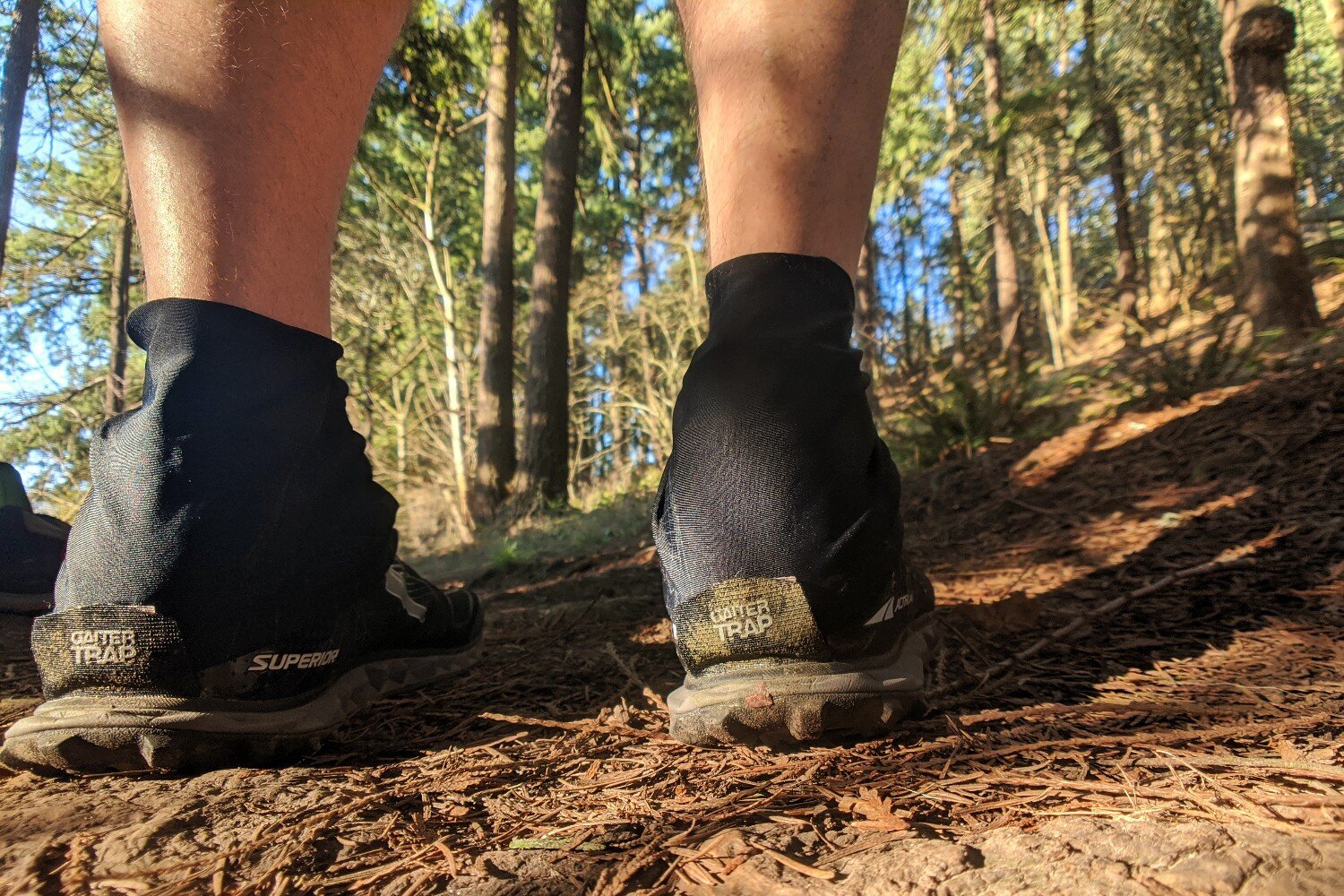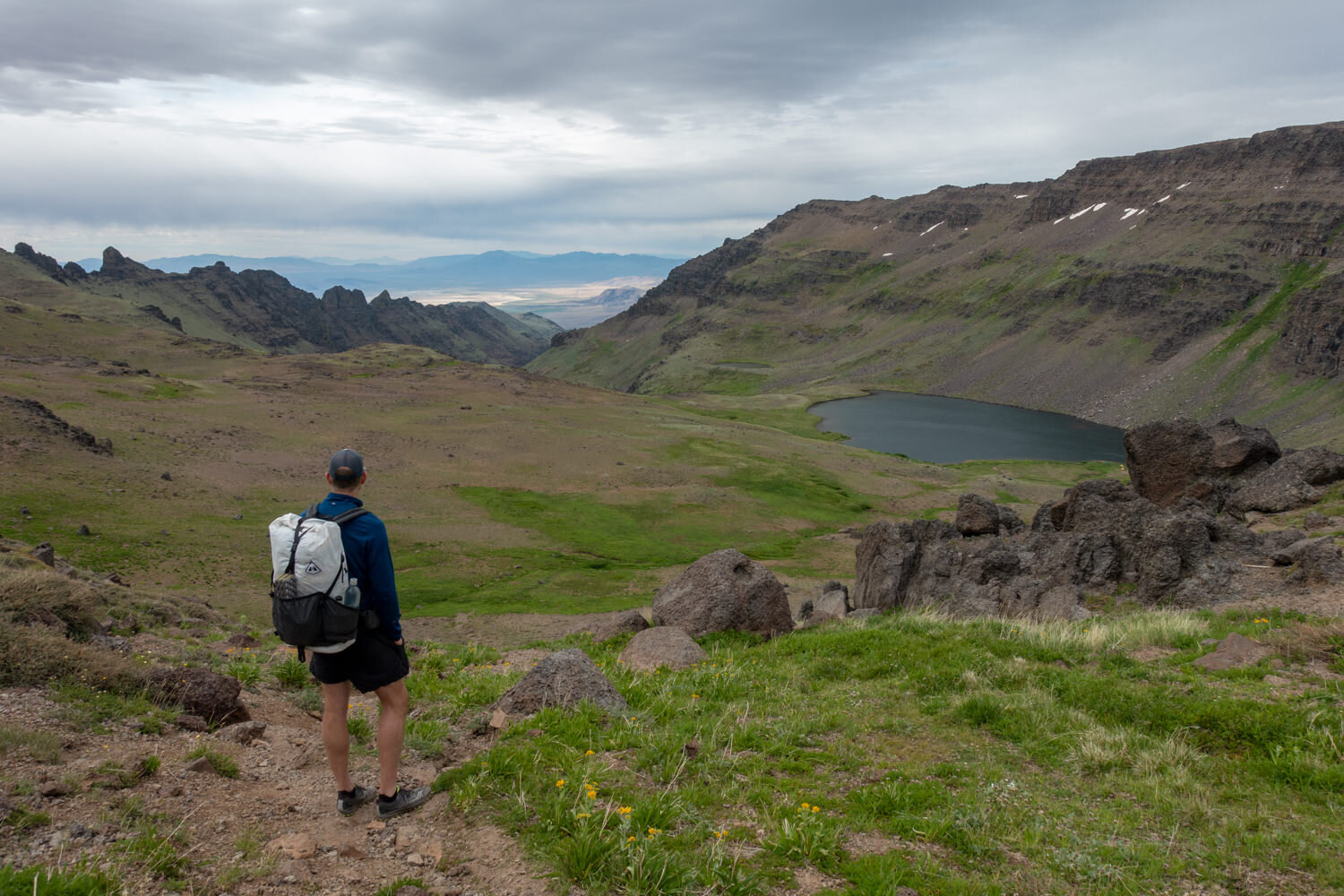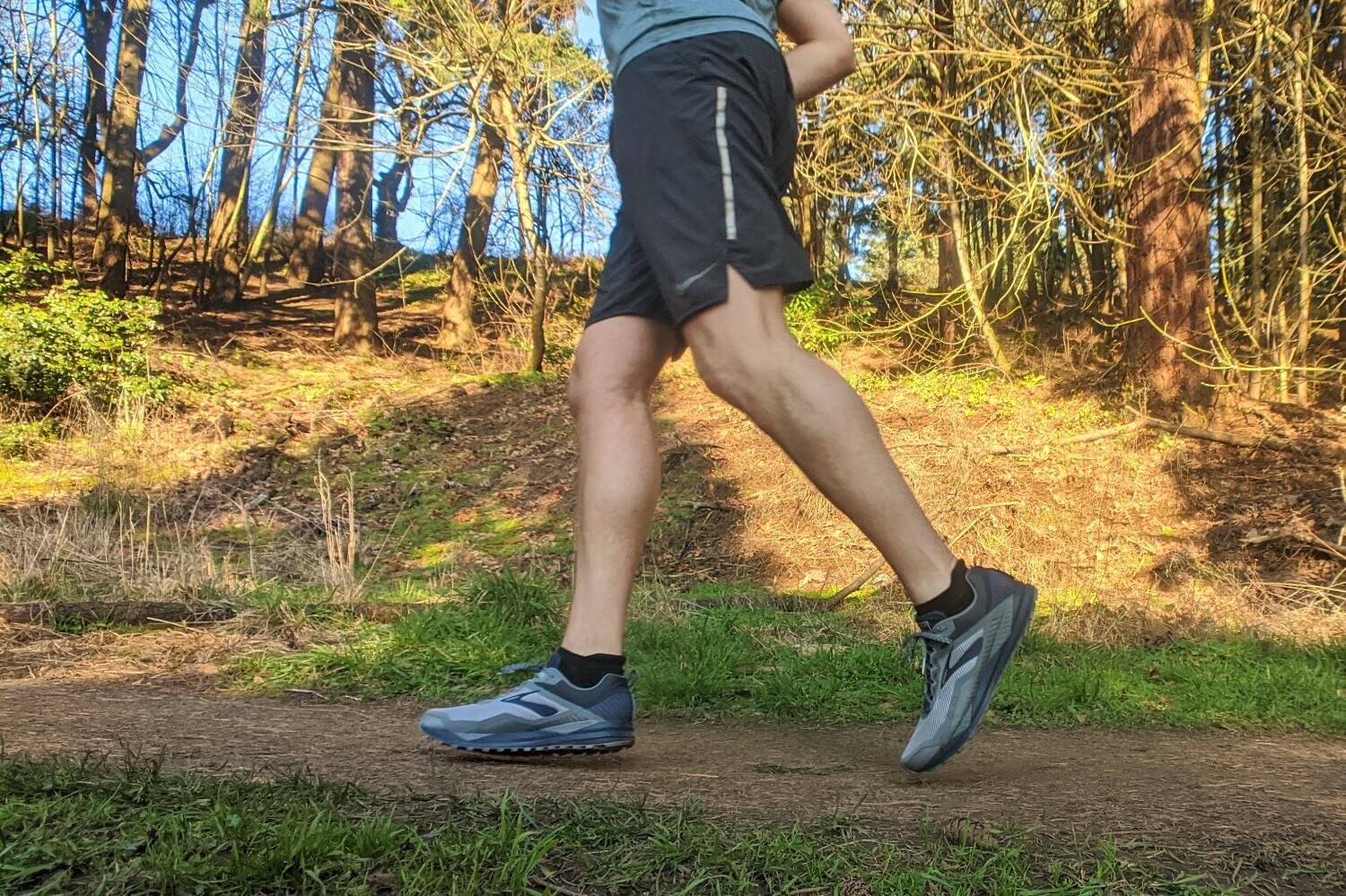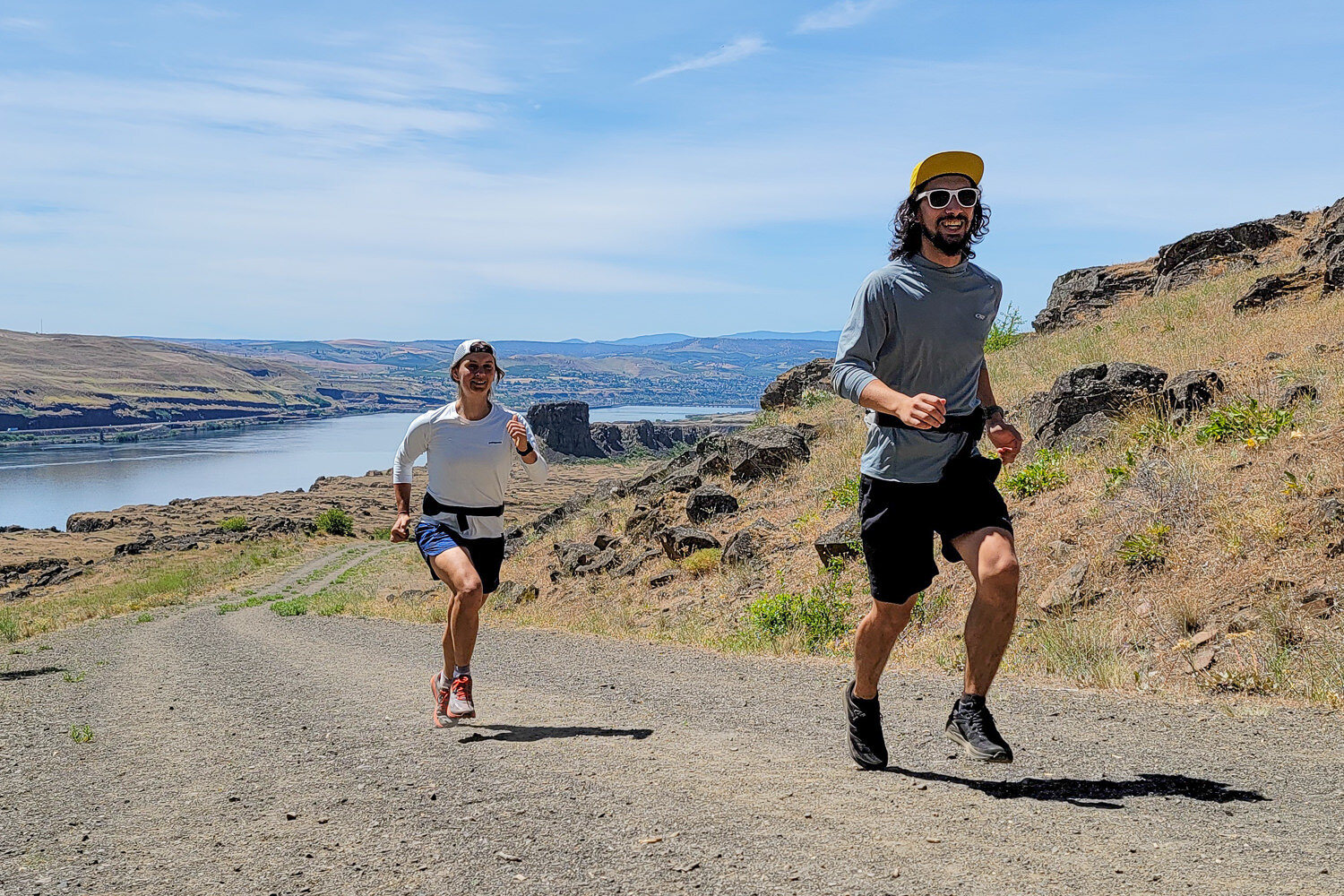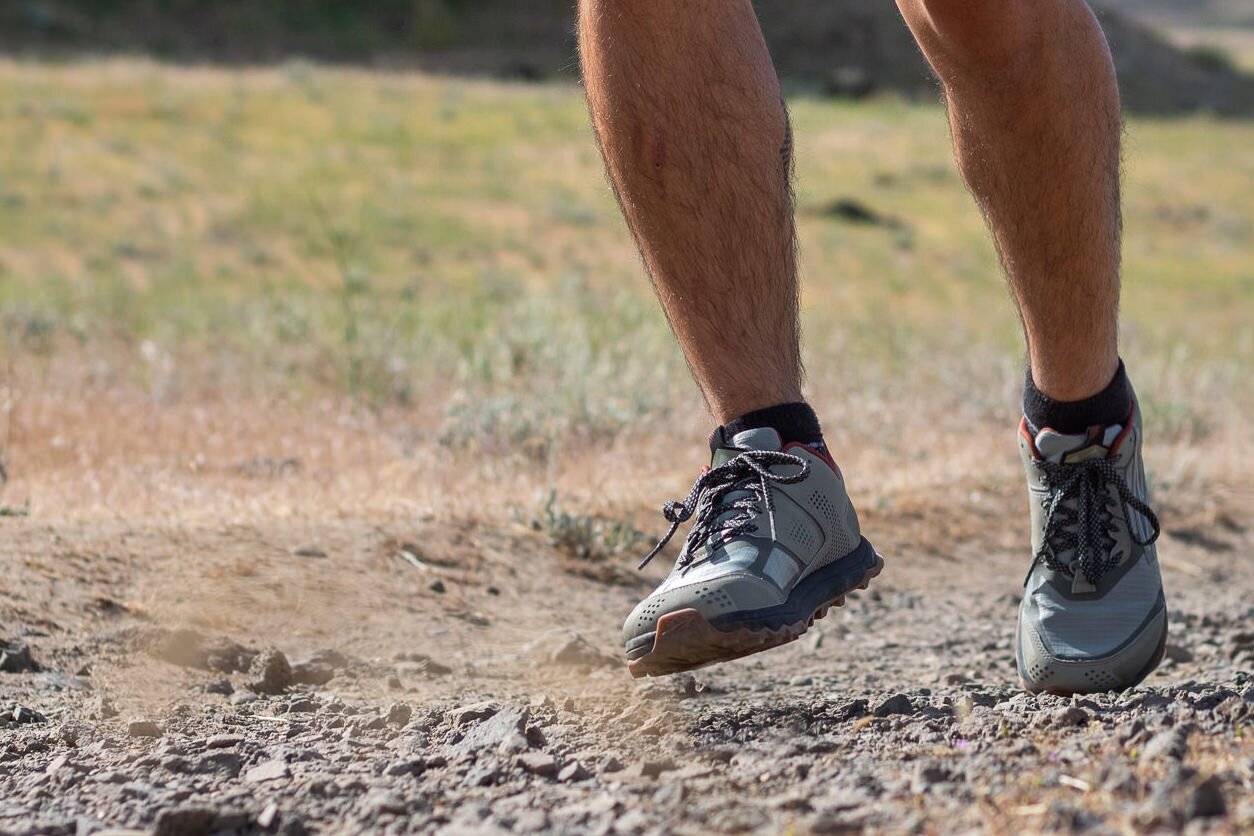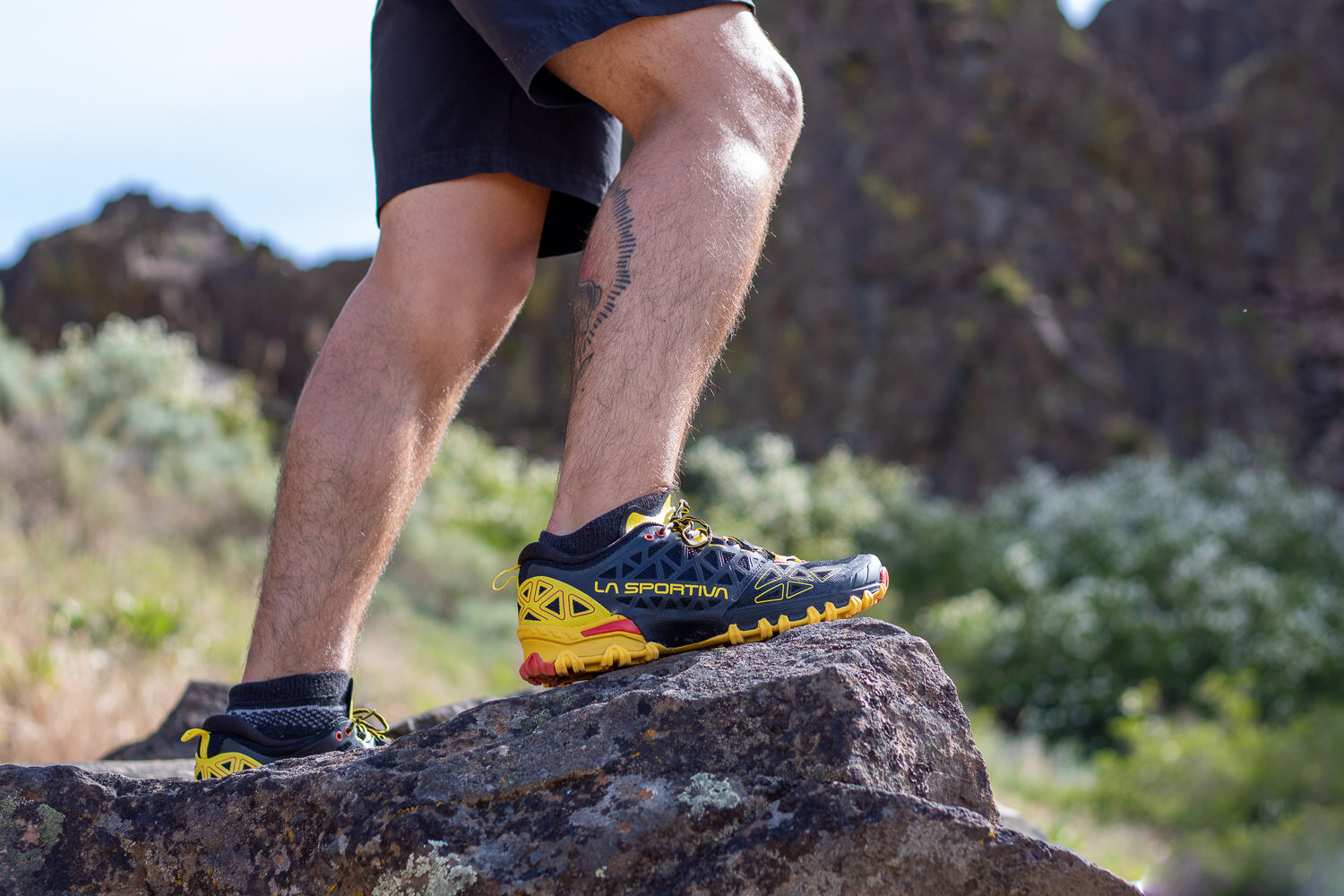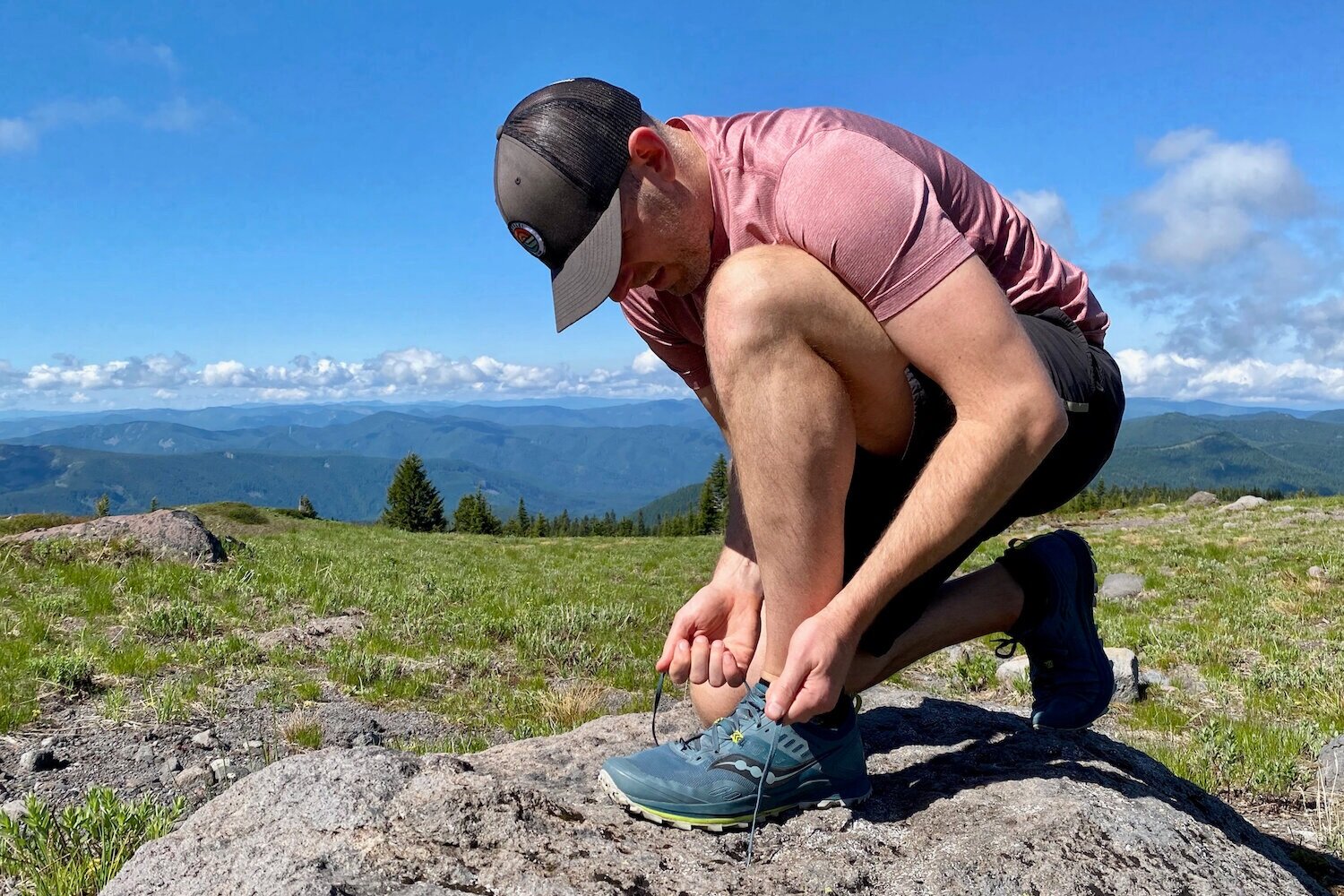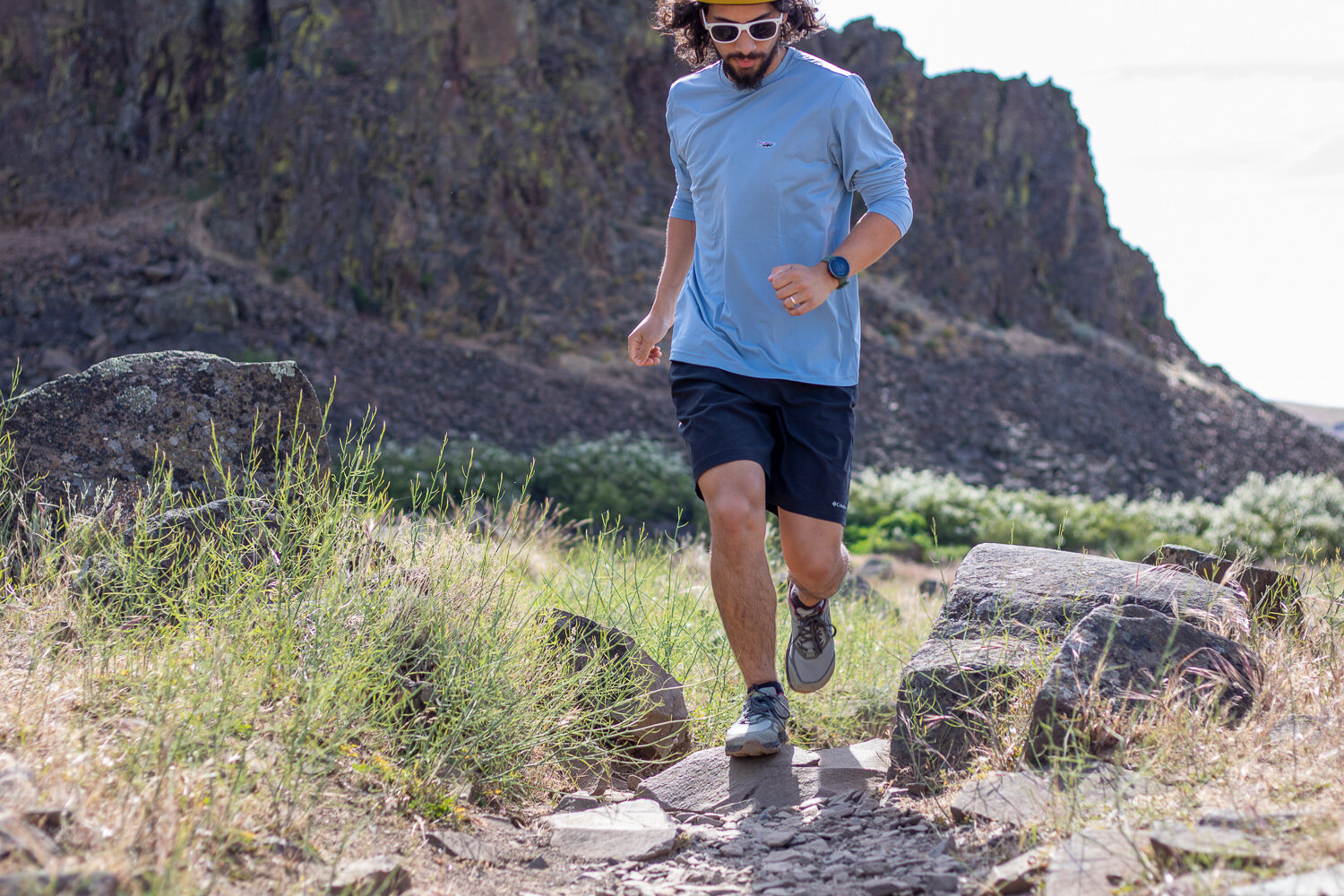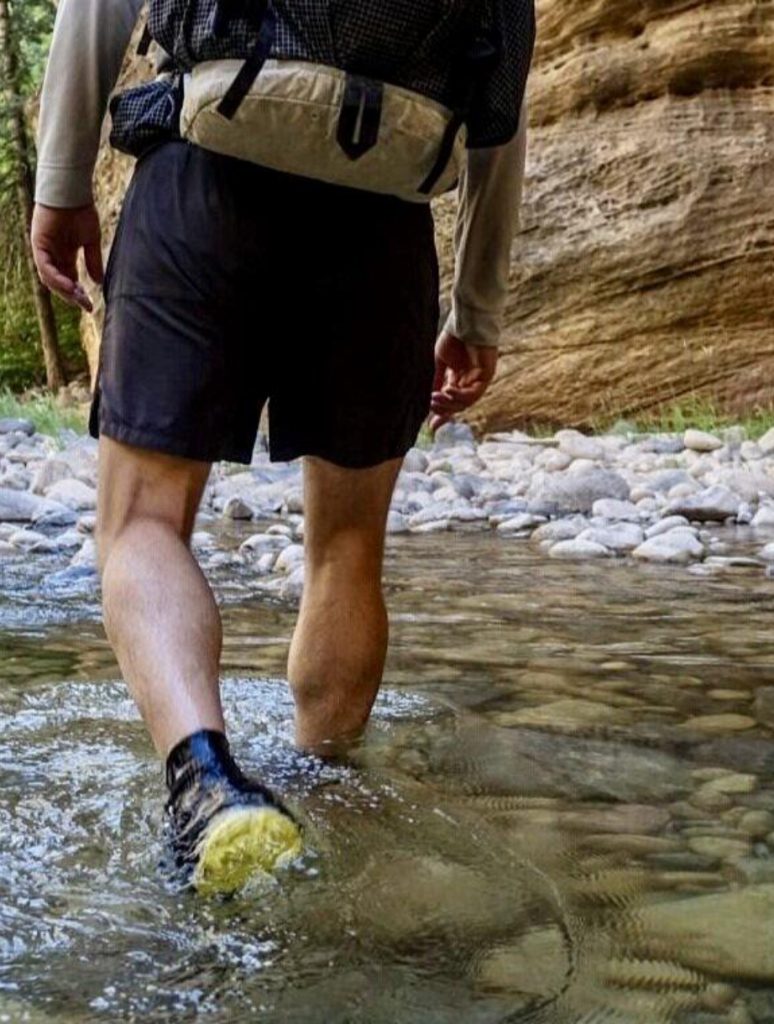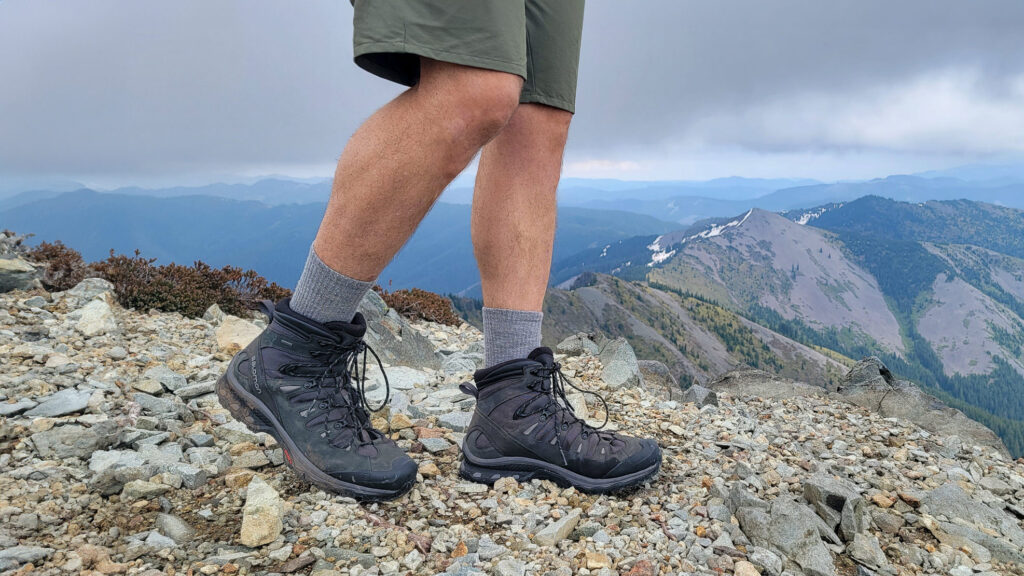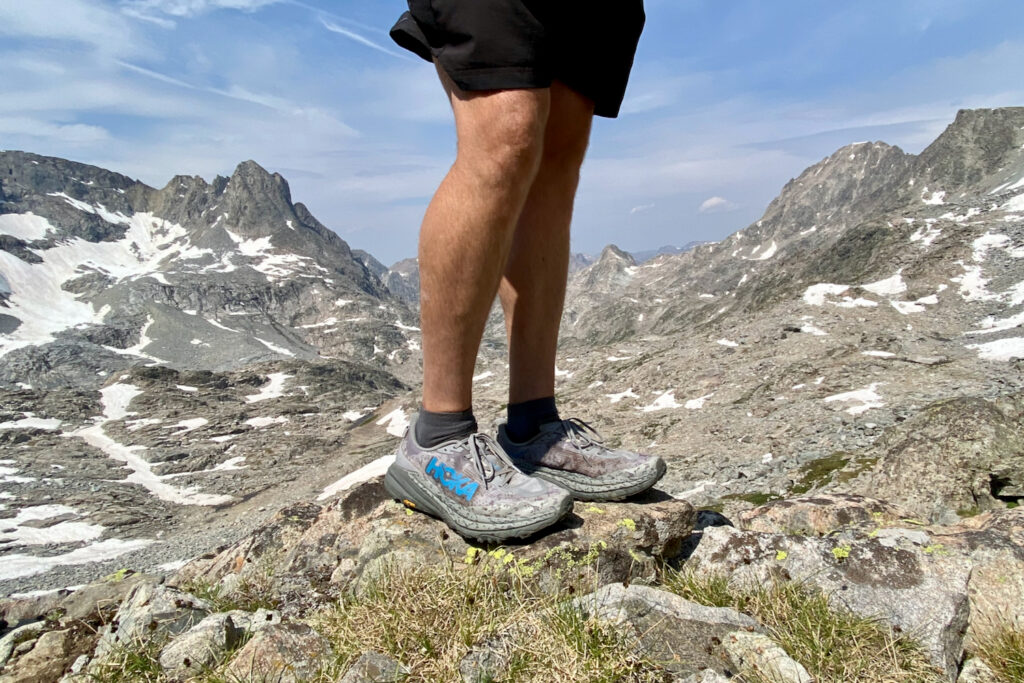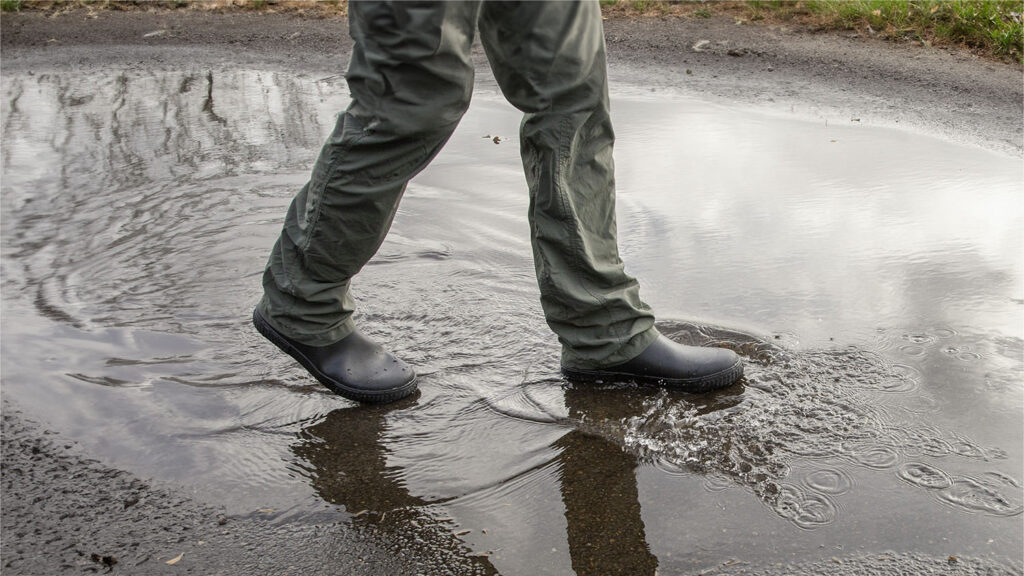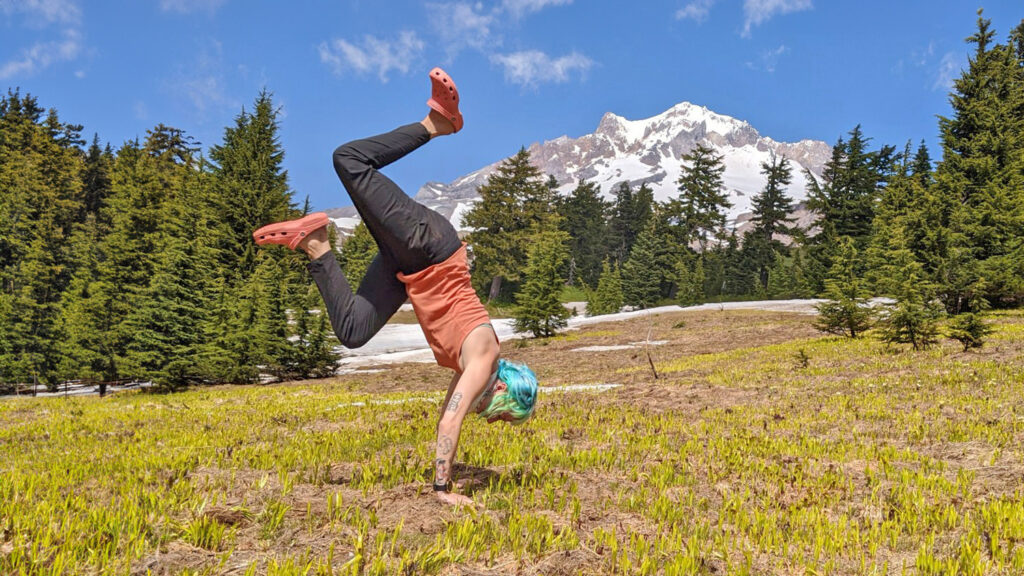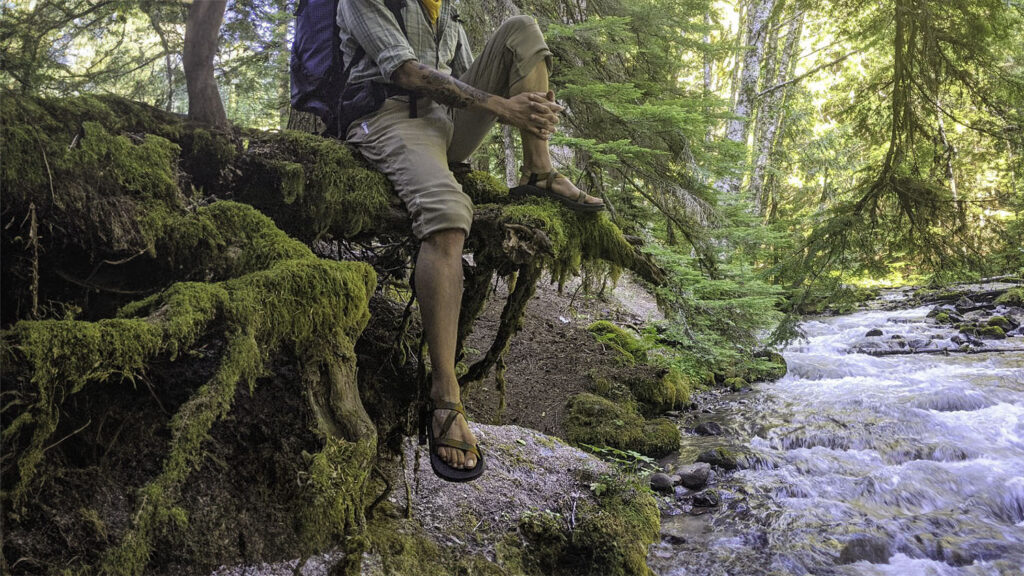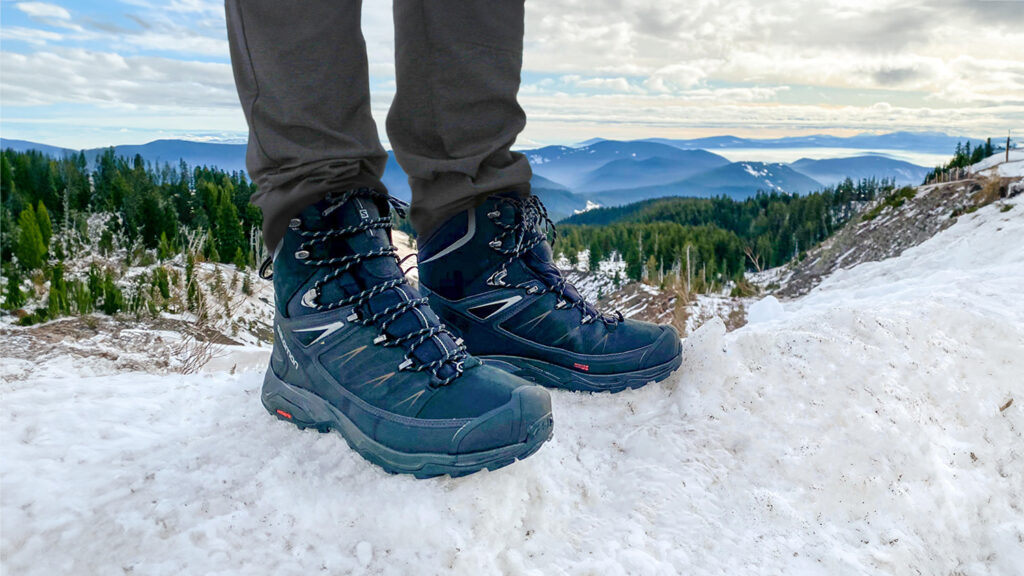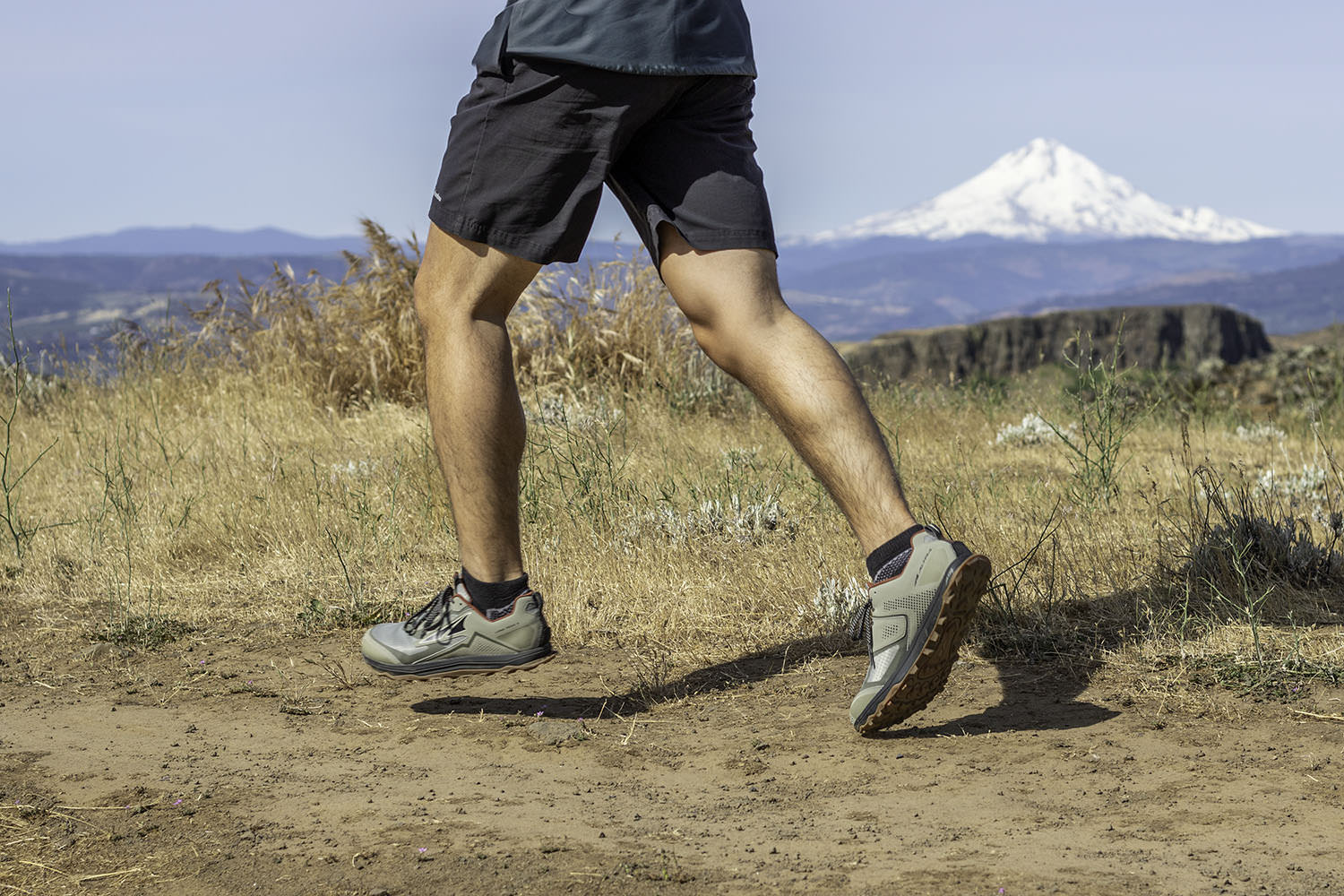
Whether you’ve been a hardcore trail runner for years or you’re transitioning from sidewalks to singletrack, the right pair of running shoes is essential for a fun and healthy running season. From muddy, rocky trails to sandy, steep routes, trail runners are the key to staying comfortable, agile, and stable in any weather.
Our full-time gear testers have been hard at work testing over 30 running shoes over thousands of miles of trail, taking on the arid Arizona desert, rocky Colorado high country, and soggy rain forests of the Pacific Northwest to narrow down the best of the best. When it comes to comfort, weight, durability, and price, the shoes on this list leave the rest in the dust.
We’ve also done the legwork for trail running shoes for women. If you want something burlier for your next trail outing, our guide to the best hiking shoes has tons of recommendations. For the dedicated (or aspiring) ultra runner, we’ve got the best running vests, as well as top GPS watches for people who want to track their stats.
Quick Picks for Men’s Trail Running Shoes
Check out this quick list of our favorites if you’re in a hurry, or continue scrolling to see our full list with in-depth reviews.
Best trail runners overall: Brooks Catamount 4 ($170)
Ultralight trail runners for technical terrain: Nnormal Kjerag ($195)
Durable trail runners for rugged trails: La Sportiva Bushido III ($145)
Trail runners with a great balance of traction, low weight & comfort: Saucony Peregrine 15 ($145)
Affordable trail runners that excel on muddy routes: Salomon Speedcross 6 ($145)
Best budget trail runners: HOKA Torrent 4 ($130)
Best trail runners with a natural foot shape: Topo Athletic Ultraventure 4 ($150)
Supportive trail runners with a rockered sole: The North Face Vectiv Enduris 3 ($149)
Best trail runners overall: HOKA Speedgoat 6 ($155)
Reliable trail running shoes with a classic design: Brooks Cascadia 19 ($140)
Best zero-drop trail runners: Altra Lone Peak 8 ($140)
Best waterproof shoes for wet & cool weather: Nike React Pegasus Trail 4 GTX ($160)
What’s new
After pounding out countless miles in the latest models, we’ve reshuffled our trail runner rankings with exciting new contenders and a few unexpected shakeups.
- The Brooks Catamount 4 takes our number one spot thanks to its responsive ride and awesome blend of low weight and excellent traction.
- We welcome the Nnormal Kjerag, one of the lightest and most technical racing shoes on the market, to the top 3 with its airy feel and excellent all-arund performance.
- The La Sportiva Bushido III earns an Editor’s Pick badge for its sticky updated traction and protective features that thrive on tough terrain.
- We’ve added the HOKA Torrent 4 as one of the best bangs for your buck when it comes to a lightweight trail shoe that tackles obstructions with ease.
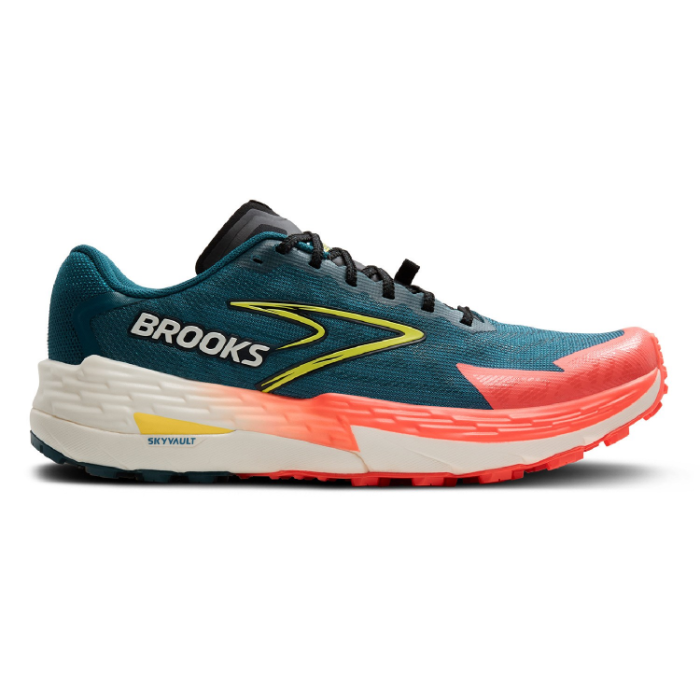
Brooks Catamount 4
Best trail runners overall
CleverHiker Rating: 4.9/5.0
Price: $170
Weight (Pair): 1 lb. 3 oz.
Heel-to-Toe Drop: 6 mm
Cushioning: Moderate
Best For: Mixed Terrain
Pros
- Lightweight
- Excellent traction for steep ascents / descents
- Durable materials
- Comfortable on long runs
- Good for mixed pavement & trail
- Breathable uppers
- Larger toe box
- Protective toe cap
- Excellent laces
Cons
- Expensive
- Less cushioning than some
- A bit narrow
- Plate makes shoe feel a bit stiff
- No heel loop
- Traction falls short on soft terrain
The nimble, durable, and comfortable Brooks Catamount 4 takes the top spot on our trail runners guide- and for good reason. This version brings some smart updates that immediately made them a team favorite. With a refreshed tread pattern, springy propulsion plate, and impressive durability, these things are super versatile for runs and hikes of all kinds – from paved riverwalks to packed singletrack to backcountry scrambles.
The Catamount is a true trail shoe built for steep ascents and descents. It offers plenty of arch support and has a slightly larger toe box to prevent toe jamming on downhills. Brooks redesigned the lugs with a sharper geometric shape, and the outsole gets a pattern refresh that grips from packed trail to technical sections. We felt more confident, speedy, and stable than ever.
Brooks tweaked the plate design, giving the Catamount 4 a snappier, more responsive ride without sacrificing comfort. They also added 2mm of nitrogen-infused foam, bumping up the heel while maintaining the shoe’s lively feel. The new tongue design and excellent lacing system keep the fit secure and comfortable on everything from flats to steep descents.
That said, the Catamount 4 has limitations. It’s stiff on more technical or uneven ground, and traction underwhelms on sand, mud, and soft surfaces. The narrow fit won’t suit everyone, and there’s still no wide option. Plus, with only a couple color choices and a steep price tag, it’s not for every budget.
Still, for runners who want a lightweight, breathable, and impressively durable shoe that can handle long miles with speed and confidence, the Catamount 4 remains one of the best trail runners out there.
More: Brooks Catamount 4 Review
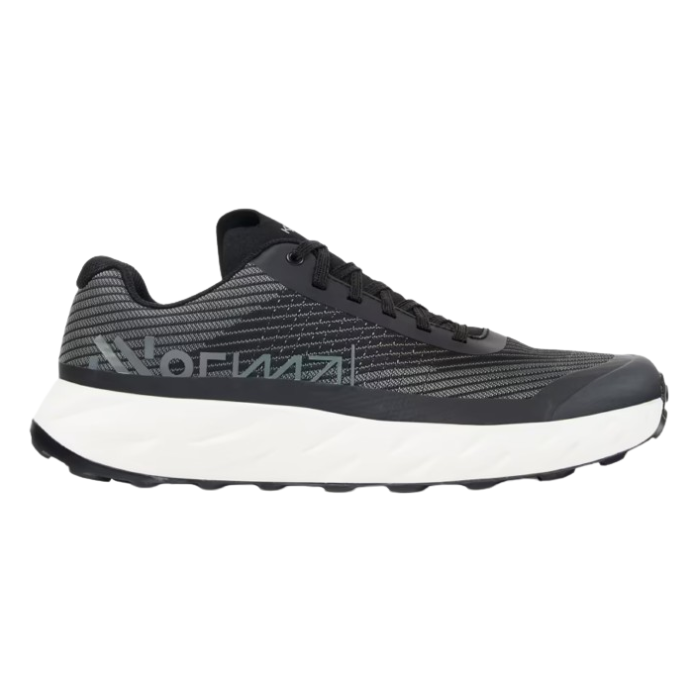
Nnormal Kjerag 01
Ultralight trail runners for technical terrain
CleverHiker Rating: 4.8/5.0
Price: $195
Weight (Pair): 14.5 oz
Heel-to-Toe Drop: 6 mm
Cushioning: Minimal
Best For: Technical / Trail
Comfort: 4.3
Pros
- Ultralight
- Responsive
- Very durable
- Good heel cushioning
- Sensitive ground feel
- Versatile for technical routes & packed triails
- Excellent traction
- Top-tier materials
Cons
- Expensive
- Too long (size down 1 full US size)
- Runs narrow
- Lack of insole isn’t for everyone
The Nnormal Kjerag is an incredibly lightweight, durable, and technical trail runner pushing the evolution of performance shoes. It’s a close runner up to the top spot because it’s fast, responsive, and incredibly durable for how lightweight they are.
The brainchild of Killian Jornet – one of the fastest and most efficient runners of our lifetimes – the Kjerags are predictably built for performance. At 7.2 ounces per shoe the Kjerags are the lightest on this list, for a seriously airy and spry feel. But they remain very durable thanks to a simple, time-tested upper design, outstanding craftsmanship, and a burly outsole. We find they’re versatile and bombproof from packed trails to messy scrambles.
Our primary complaint is around the stiffness of the sole. This design is unrivaled for a precision step – if you’re edging across gnarly roots, rocks, and obstructions, the Kjerag delivers outstanding control. But they’re a bit firm on pavement and packed trail, making them too technical for every day trainers. But on moderate trails and beyond, these shoes will help you fly through long days on complicate, varied routes.
The other downside? Their price tag is steep. However, the premium price delivers an awesome performance on trail for almost any adventure outside. If you’re looking for a top-tier shoe for your next 50K trail race, or plan to set a PR on a long-distance effort, the Kjerag can’t be beat.
If you’re looking for a less aggressive shoe overall, check out the Nnormal Tomir 2.0. It’s a great daily trainer with a softer sole and a lower price tag.
More: Nnormal Kjerag Review
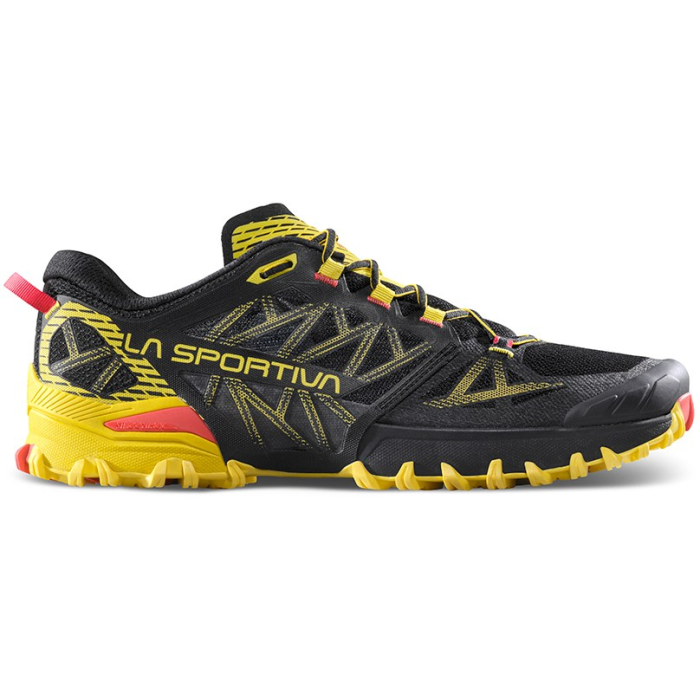
La Sportiva Bushido III
Durable trail runners for rugged trails
CleverHiker Rating: 4.7/5.0
Price: $155
Weight (Pair): 1 lb. 5 oz.
Heel-to-Toe Drop: 6 mm
Cushioning: Moderate
Best For: Technical
Pros
- Outstanding traction
- Durable construction
- Protective uppers
- Stable on technical trails
- Excellent arch support
- Large rock plate
- Wide fit option
- Heel loop for easy on / off
Cons
- Stiffer soles not great for mellow terrain
- Flimsy laces
- Upper mesh not as durable as some
- Narrow toe box
- Runs a bit warm
The La Sportiva Bushido III is our all-time favorite trail runner for rugged, mixed-terrain trails. Whether you’re new to running singletrack or you’re a seasoned veteran, these shoes are fast, nimble, and durable when the trails get tough thanks to a protective and burly build, supportive and snug fit, and outstanding traction.
Gear analyst Ian Krammer’s climbed 300+ Colorado peaks over 13,000 in the Bushidos. With Bushidos, he’s taken on tens of thousands of feet of vert and hundreds of miles in the gnarliest alpine landscapes. The verdict? These things offer 4-Wheel Drive when the trail gets tough.
Want a shoe that can go the distance? With reinforced mesh zones on the uppers, ripstop fabric and TPU overlays, abrasions are no match for the Bushido III . The beefy rubber toe cap protects against sharp rocks and stubbed toes, and the stout heel counter offers top-tier stability from scree fields to gravel gullies.
Keep in mind, though, the Bushido is built for alpine environments – not hard-packed trails or pavement. We found the stiff sole, chunky traction, and meticulously engineered upper really are best on rugged terrain. These shoes are overbuilt for casual runners, so if you’re sticking to the local trails and lower elevation single track, this might be too much.
But if you’re regularly running tough miles in rocky, technical terrain, the Bushido IIIs will kick your performance to the next level. Thanks to stellar durability and aggressive grip, you can forge your own path from base camp to summit.
More: La Sportiva Bushido III Review
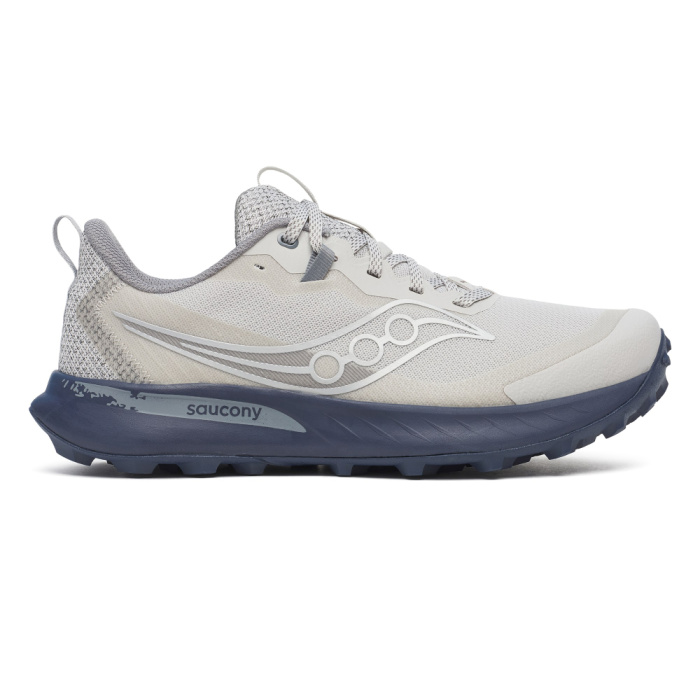
Saucony Peregrine 15
Trail runners with a great balance of traction, low weight & comfort
CleverHiker Rating: 4.6/5.0
Price: $145
Weight (Pair): 1 lb. 3.4 oz.
Heel-to-Toe Drop: 4 mm
Cushioning: Moderate
Best For: Mixed Terrain
Pros
- Excellent traction
- Breathable
- Cushier midsole than prior version
- Lightweight
- Secure fit
- Rock plate protects arches
- Comfortable
Cons
- Outsoles wear down quickly
- 20-25 mile break-in period
- Narrower toe box than prior version
- Occassional rubbing at heel
Our team has been running in every iteration of the Saucony Peregrines since they came out, and the 15s are better than ever. The latest iteration features a next-gen foam midsole that’s both more responsive and cushy than the 14. Our testing finds they are seriously comfortable over long miles on any terrain, whether we were chasing a PR on loose dirt in the foothills or cruising in Zone 1 on paved urban routes.
This version is a big step forward when it comes to traction. Saucony updated the pattern by adding more lugs through the midfoot and heel, and we noticed the difference. These offer far better braking on steep downhills than the prior version, and they still perform well on rolling hills and flats.
The details are what set the Peregrines apart. A large heel loop makes them easy to pull on, the cushy tongue is padded and comfortable, and they have a snug, sock-like fit. The rock plate adds good protection underfoot for rocky sections of trail, and a 360° rand adds a bit more structure and protection. The lace spacing makes for a great lockdown across the top of the foot.
However, the Peregrine 15 has an updated fit that might not work for everyone. The heel counter is more structured, the cuff is slightly taller, and the toe box is a bit narrower. This combination of changes translates to a longer break in time than prior versions – for us, it took 20 to 25 miles before they softened up, and we had some hot spots and chafing out of the box.
Our other knock on the Peregrines is their lack of durability. The outsoles have better traction, but the durability is the same as prior versions, with the lugs wearing down noticeably after 250 miles. We also find the mesh uppers and TPU overlays tend to wear out beyond this point as well.
However, the Peregrines are at the top of the trail runner game when it comes to lightweight, breathable, and comfortable shoes. For those who want an affordable, nimble, and stylish option for big miles and long days, you can’t go wrong with the Peregrines.
More: Saucony Peregrine 15 Review
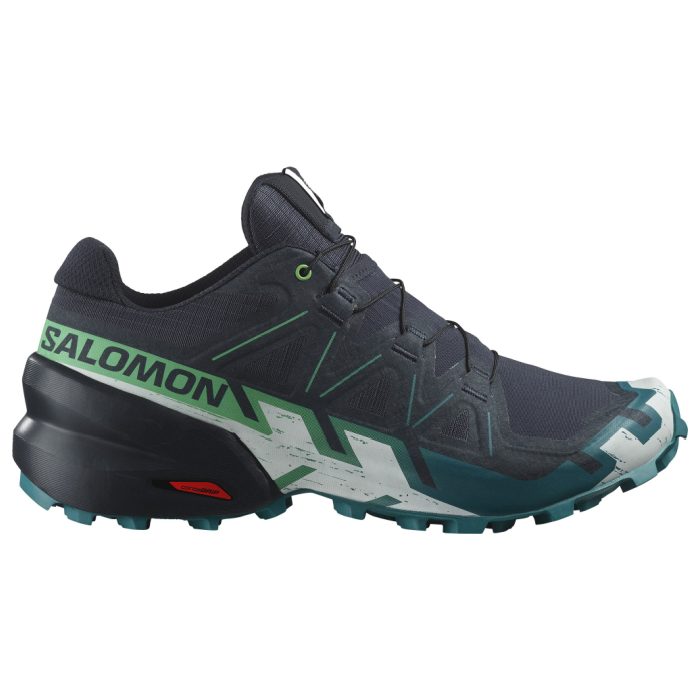
Salomon Speedcross 6
Supportive trail runners that excel on muddy terrain
CleverHiker Rating: 4.5/5.0
Price: $145
Weight (Pair): 1 lb. 5 oz.
Heel-to-Toe Drop: 10 mm
Cushioning: Moderate
Best For: Mixed terrain
Pros
- Excellent traction on soft terrain
- Good arch support
- Comfortable & snug fit
- Sheds debris easily
- Stash pocket for laces
- Cushy ankle cuff
- Good protection
Cons
- Quicklace system takes getting used to
- High heel-to-toe-drop
- Runs narrower
- On the heavy side
- Outsoles not as durable as some
Every iteration of the Salomon Speedcross has made our list, and we’re pleased to welcome the Speedcross 6 as well. Like prior versions, this Salomon model offers excellent arch support, a snug fit, and stellar traction that really shine during fast runs on wet and soft terrain.
If you’re the type that frequently tackles trails with lots of loose ground like gravel, mud or sand, the Speedcross 6s are your new best friend. These shoes have deep lugs that give reliable traction in muck, gravel, snow, and other soft surfaces. The aggressive tread pattern bites the ground for a super reliable step, and lugs are spaced enough to easily shed debris.
We’re also big fans of the Speedcross 6 for their glove-like fit and outstanding arch support. Those who prefer running shoes with a snug feel will love these things. That said, if you have wide feet or you’re betweensizes, we highly recommend going with the wide version.
They aren’t perfect, though. The Speedcross has a very tall heel-to-toe drop that can feel tippy and unstable on technical terrain and steep downhills. The Quicklace system is fast and efficient, but not everyone will like this system. There’s no way to adjust pressure across the foot, so it’s not customizable compared to regular laces.
We also found that the soles – including traction – wear flat faster than other trail runners on our list. The Speedcross shoes are well-built, but softer rubber composite wears on rocky terrain and asphalt. When we ran on mixed terrain – trail, pavement, and packed dirt – we averaged about 300 miles before the lugs were noticeably worn.
That said, there’s no need to tread lightly with the Speedcross 6. If you’re looking for specialty footwear for soft terrain, these are the kicks for you: grippy, comfortable, and sleek.
More: Salomon Speedcross 6 Review
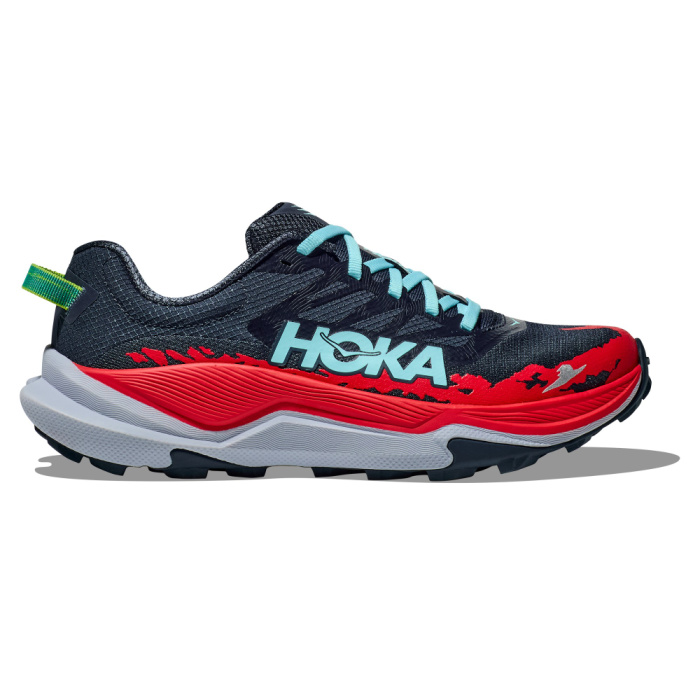
HOKA Torrent 4
Best budget trail runners
CleverHiker Rating: 4.4/5.0
Price: $130
Weight (Pair): 1 lb. 1.4 oz.
Heel-to-Toe Drop: 5 mm
Cushioning: Moderate
Best For: Trail
Pros
- Less expensive
- Ultralight
- Breathable upper
- Good traction on dry terrain
- Supportive arch
- Responsive & springy
- Sturdy midsole
- Newly added heel loop & extra eyelet
Cons
- Durability is questionable
- Firmer midsole
- Narrow toe box
- Rocker geomtery isn't for everyone
If you’re looking for the best bang for your buck, the HOKA Torrent 4 is tough to beat. This model offers an outstanding value for entry-level trail runners and is an excellent choice for daily runs and taking on moderate routes and long races.
The Torrents are some of the lightest shoes on this list, and we noticed. At just over a pound for the pair, they are impressively breathable and well-ventilated thanks to soft mesh uppers. The slightly rockered sole and curved toe spring lend a nice energy return with each step, making them feel responsive, but not bouncy.
HOKA updates the Torrent 4 with a slightly cushier midsole foam, though they are still fairly stiff compared to the other HOKA model on this list, the Speedgoat 6. The Torrents are still lighter and offer a more traditional slim, sturdy, and stiff performance profile. That directly translates to strong arch support and stability most terrain. Instead of the hefty cushioning of the Speedgoats, you’ll get a much better ground feel and improved edging on rocks and slightly technical terrain.
The biggest downside of the Torrents is their lack of durability. Since the all-mesh uppers of the Torrents aren’t reinforced, we find the material doesn’t last as long as others on this list, and the rubber compound on the outsole wears out faster as well. We got about 250-300 miles in these shoes before they began to show major wear and tear. That said, these are ultralight shoes, and durability is always an issue for thinner products like these.
They’re also a bit of a narrow fit through the midsole and the toes – and they don’t come in a wide version. Combined with a slightly more dramatic rocker design than other shoes, the Torrent 4s might not work for everyone’s feet, gait, or running style.
But for this price, the Torrents are still an awesome value. If you want comfortable, lightweight, and less expensive trail runners, these come in a variety of colorways to match any style.Whether you’re looking to crush your summer training cycles, you run regularly in warm and dry climates, or simply want to get out on the trails, these are the kicks for you.
More: HOKA Torrent 4 Review
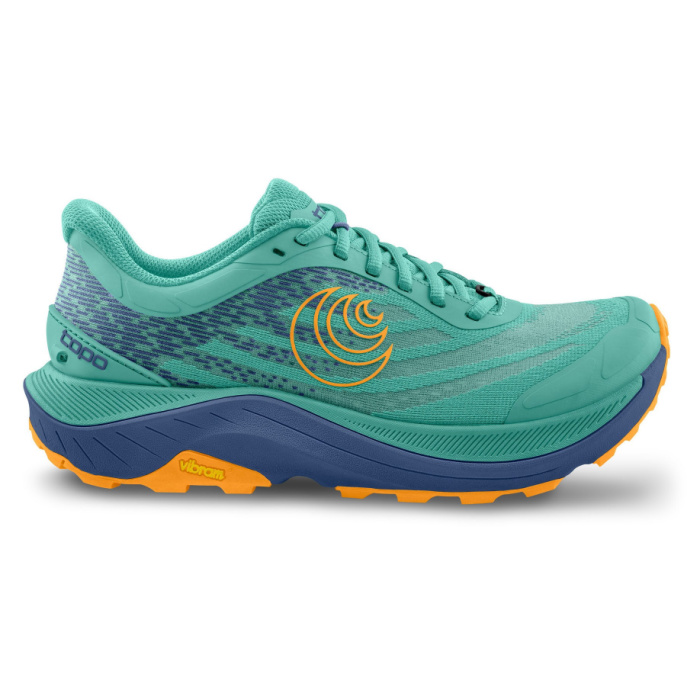
Topo Athletic Ultraventure 4
Best trail runners with a natural foot shape
CleverHiker Rating: 4.3/5.0
Price: $150
Weight (Pair): 1 lb. 4.8 oz.
Heel-to-Toe Drop: 5 mm
Cushioning: Moderate
Best For: Trail
Pros
- Lightweight
- Roomy toe box
- Comfortable ride
- Breathable uppers
- Fast drying materials
- Flexible
- Versatile for road to trail
- Supportive insole
Cons
- No heel tab for easy on / off
- Not as durable as some
- Lacing adjustments can be tedious
- Softer ankle cuff isn’t for everyone
- Shallow lug depth is best for moderate terrain
We love the Topo Athletic Ultraventure 4 for its wide toe box, super breathable uppers, and plush, flexible soles. This is the first update to the Ultraventures in a long time, although very little has changed. The 4’s get a tighter weave pattern in the uppers, slightly better ankle security with a different TPU layout, and a tighter lockdown at the heel. Our testing finds these are as comfy as ever, though: for long running days and big miles on the trail, the versatile Ultraventures remain one of our faves.
What sets the Ultraventures apart is their natural foot shape, with a large toe box, narrower heel cup, and midfoot that hugs close. And if you’re looking for out-of-the-box comfort, the Ultraventures are good to go right away. We found they didn’t need much break-in time at all. The padded tongue and pleasantly soft insoles inspired confidence immediately.
The compromise with the Ultraventures is traction depth. The lugs are not deep enough to bite effectively on wet rocks or trails with lots of steep ascent and descent. We prefer these for easy and moderate established trails.
The Ultraventures are great for hot runs because of their ultra-ventilated mesh uppers, and they dry impressively fast. The downside of this design? They don’t last as many miles as shoes made with TPU reinforcements or thicker construction. Still, we’re averaging around 400 trail miles before fabric starts to break down.
For a lightweight shoe with a bit of extra wiggle room for your toes, superior ventilation, and a stable ride, the Ultraventure 4’s help us stay ahead of the pack.
More: Topo Athletic Ultraventure 4 Review

The North Face Vectiv Enduris 4
Supportive trail runners with a rockered sole
CleverHiker Rating: 4.3/5.0
Price: $160
Weight (Pair): 1 lb. 4.2 oz.
Heel-to-Toe Drop: 6 mm
Cushioning: Maximum
Best For: Mixed Terrain
Pros
- Durable construction
- Comfortable out of the box
- Cushy foam
- Rockered sole is propulsive
- Good arch support
- Excellent lacing system
- Reliable traction on mixed terrain
- Great lateral stability
Cons
- Outsole is bulky
- Narrow fit
- Less breathable uppers
- Not as responsive as some
- No heel loop
The North Face Vectiv Enduris 4 is a cushy trail runner for trail-to town routes. The 4’s earn their spot on our list with an ergonomic design, excellent durability, and a foam-forward ride that we can’t get enough of.
These babies are comfortable right out of the box and need very little break-in time. In fact, we felt so confident in them, we went straight to the trailhead for a quick out-and-back after picking them up. The Enduris 4 have plenty of foam through the midsole for a soft, forgiving ride that keeps momentum. Plus, this shoe is in the upper half of the pack for weight, so they won’t drag you down.
The Enduris 4 has a slightly rockered sole with a TPU plate for stability, which walks a fine line between stability and cushioning. We love this design for long-distance efforts on moderate trails: the curved toe spring makes moving forward on each step just a bit easier, and the energy return on the heel strike is noticeable. In other words, this is a fun shoe that will make you feel speedy on most routes.
On the flip side, they aren’t the most responsive shoe, and the outsole is bulky compared to other shoes. Don’t get us wrong – it’s comfy and super stable – but this combo can feel clunky on technical terrain and steep uphills, which is why it’s a bit lower down our list – and it’s not the most streamlined shoe, either.
We also find the double-layer uppers run hot – our feet were sweating above 80°, although this thick design is super durable. Also, the fit won’t work for everyone as they’re fairly narrow, so those with wider feet may not love this design.
Still, the Enduris 4s are durable and comfortable trail runners that perform on trail and pavement. They are a soft, forgiving ride that we look forward to mile after mile. Overall, we think are a major improvement over the prior versions, and are one of our faves for daily town-to-trail runs or hitting a PR in the 10K.
More: The North Face Vectiv Enduris 4 Review
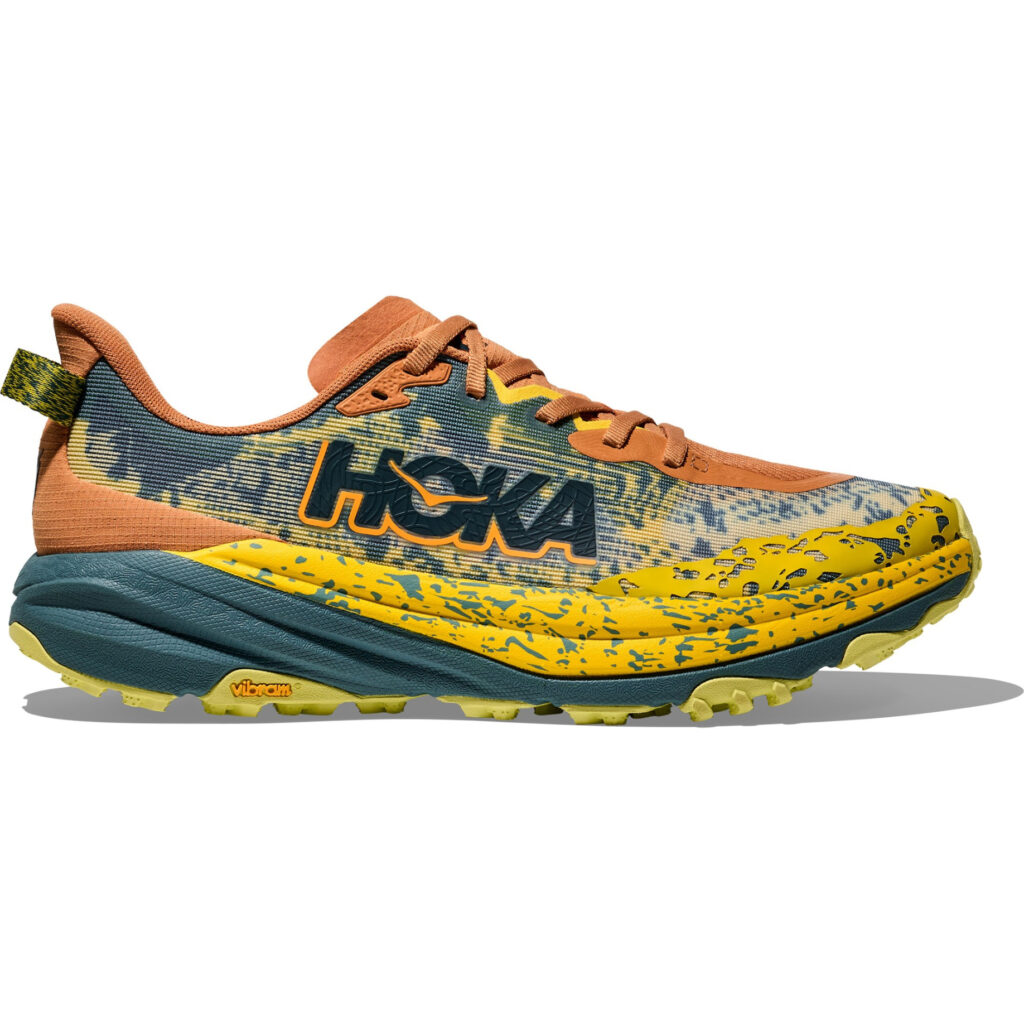
HOKA Speedgoat 6
Comfy and breathable shoes with a firmer sole
CleverHiker Rating: 4.1/5.0
Price: $155
Weight (Pair): 1 lb. 3.6 oz.
Heel-to-Toe Drop: 5 mm
Cushioning: Moderate
Best For: Trail
Pros
- Comfortable ride
- Excellent traction
- Supportive midsole
- Good lacing system
- Versatile for pavement or trail
- Lots of colorways
- Snug fit
Cons
- Stiffer than prior versions
- Smaller heel flare than prior versions
- Durability issues past 300 miles
- Bright colorways aren’t for everyone
The HOKA Speedgoat 6 still delivers the signature blend of support, grip, and agility that made this line famous, but with some updates that may not work for every runner. The CleverHiker team has logged hundreds of miles from city trails to alpine summits, and version 6 holds its own – with a few caveats.
This iteration trims the foam stack, which makes for a firmer, more responsive feel underfoot. That’s a big change from the foam-gobbling, ultra-cushy ride of prior versions. The shoe still smooths out rugged terrain and technical sections, but long-distance runners may notice less shock absorption compared to previous versions.
The outsole redesign is excellent – we find the Speedgoats are more grippy than the prior version. This update improves ground contact for good traction on everything from muddy switchbacks to rocky ridgelines. Keep in mind, though, that these now feature a stiffer sole, which can lead to more foot fatigue over time.
The upper’s new mesh improves breathability and drying speed, making it a strong warm-weather performer. But, the narrower toe box and midsoles may feel restrictive for some, and HOKA dramatically reduced the heel flare so they aren’t as cushy on downhills. Durability continues to be an issue with these shoes, though – we find these shoes are looking rough at the 300-mile-mark.
While no longer in our top 3 trail running shoes, the Speedgoat 6 remains a solid choice for hikers and runners seeking lightweight performance, excellent grip, and fast-drying comfort — provided you’re okay with a firmer ride than previous versions.
More: HOKA Speedgoat 6 Review
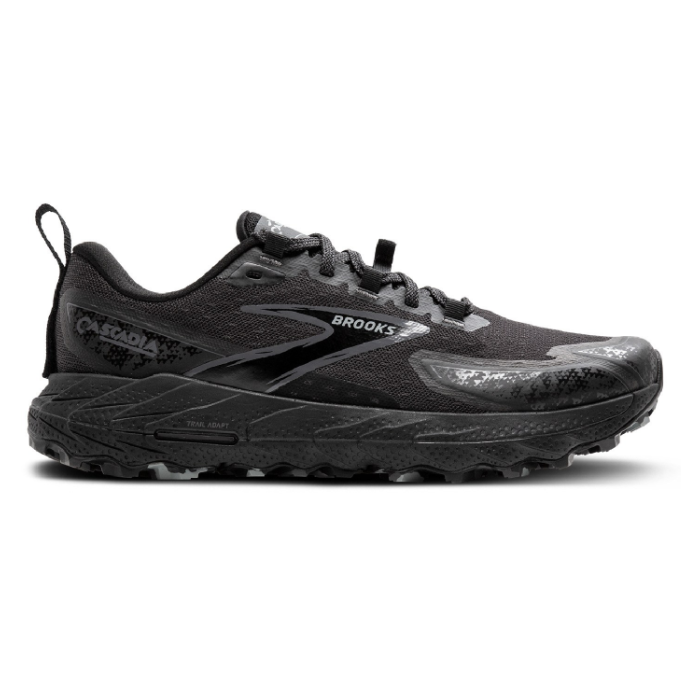
Brooks Cascadia 18
Reliable trail running shoes with a classic design
CleverHiker Rating: 4.0/5.0
Price: $140
Weight (Pair): 1 lb. 7.3 oz.
Heel-to-Toe Drop: 8 mm
Cushioning: Moderate
Best For: Mixed terrain
Pros
- Cushioned heel and midsole
- Versatile for road and trail running
- Large heel tab for easy on / off
- Flexible uppers
- Less expensive
- Reliable traction on most terrain
- Built-in gaiter attachment
- Protective rock plate
Cons
- Not as durable as some
- Less ground feel than some
- Laces can get stiff over time
- Mesh uppers blow out
- Heel cuff can be uncomfortable
If you’re looking for a running shoe with all-around performance, excellent comfort, and versatility for long miles on trail or road, the Brooks Cascadia 18 fits the bill.
Our team has been running and hiking in this model for years, logging thousands of miles on trails like the PCT, CDT, and Pinhoti. CleverHiker’s Managing Editor, Ben Applebaum-Bauch, has put 6,000+ miles on multiple versions, and the 19s remain a daily go-to for everything from trail runs to backpacking trips.
Thanks to plush foam midsoles, a supportive midfoot arch, and breathable mesh uppers, the Cascadia 18 delivers excellent comfort right out of the box with virtually no break-in time. The flexible uppers and effective lacing keep feet secure, while the springy midsoles provide plenty of cushion for pounding out long distances on packed dirt, sandy stretches, and even asphalt.
They don’t necessarily rule any one metric, but that’s their charm. The Cascadia 18’s stable ride, dependable traction, and lightweight feel make them ideal for most foot shapes and a wide range of trail conditions.
Our biggest gripe is durability. The lighter build sacrifices some toughness – we’ve come to expect mesh blowouts at the edge of the toes and worn tread after a single season of heavy use. Also, if groundfeel is important to you, the foam midsoles reduce ground feel on more technical terrain, and it’s worth noting these shoes are still on the heavier side for this category.
But the Cascadia 18 remains a stellar value. With its reliable performance, cushy ride, breathable design, and quick-drying materials, it’s an outstanding choice for anyone stacking up miles on established trails.
More: Brooks Cascadia 18 Review
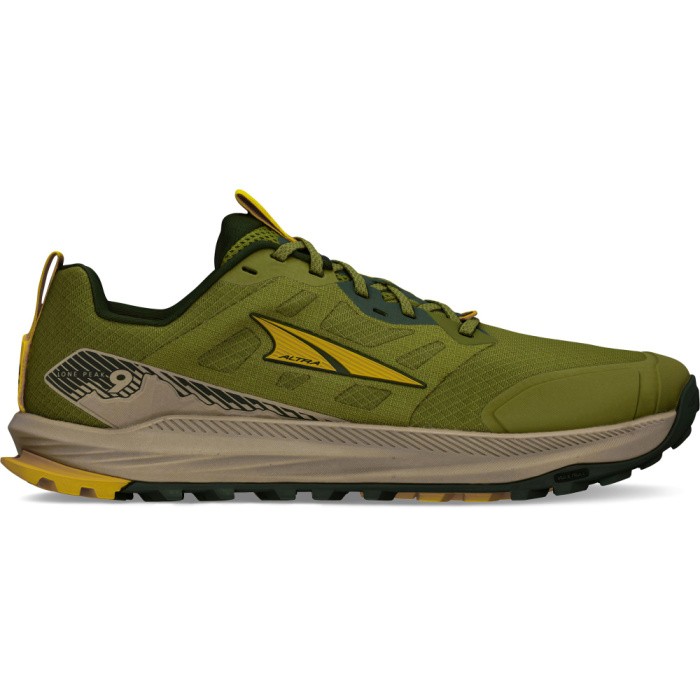
Altra Lone Peak 9
Best zero-drop trail runners
CleverHiker Rating: 3.8/5.0
Price: $140
Weight (Pair): 1 lb. 6.4 oz.
Heel-to-Toe Drop: 0 mm
Cushioning: Moderate
Best For: Trail
Pros
- Less expensive
- Roomy toe box
- Excellent traction
- Breathable uppers
- Fast drying
- Sensitive lacing system
- Built-in gaiter attachment
- Responsive, updated midsole
Cons
- Wide toe box is too roomy for some
- Not as durable
- Zero drop doesn’t work for everyone
- Heavier than competition
- Heel and cuff stiffer than prior versions
If you’re looking for the ultimate zero-drop trail shoe, the Altra Lone Peak 9 is our top choice. Every iteration of the Lone Peaks have been on our best trail runners list (and best hiking shoes guide) for years thanks to their airy feel, grippy outsole, and ergonomic foot shape.
The 9’s are an excellent version of the Lone Peaks, giving what we’ve always loved about these shoes. They have a cushy sole that offers a good balance between ground feel and protection. A natural foot shape with a huge toe box gives our piggies lots of room to wiggle. The midfoot is narrow but soft, and a newly-added set of lace holes at the ankle offer a highly customizable lacing pattern for this version.
There are lots of details to love, though. Traction gets an upgrade for more reliable grip on steep uphills and downhills. Mesh on the tongue helps them dry fast, so they vent exceptionally well on hot and dry hikes. Altra also adds a gaiter attachment loop at the front of the shoe to help keep debris out.
The main knock on these shoes is that they aren’t as durable as others on this list. It’s the reason they rank lower – our pairs were looking rough at only 200 miles. The updated heel cuff isn’t as cushioned or comfortable as the prior version, which means there’s a longer break in period and they aren’t as comfy out of the box. And, Lone Peaks remain one of the heavier pairs we reviewed compared to other trail runners.
Additionally, zero-drop shoes aren’t for everyone. Keep in mind that going from higher heel-to-toe-drop footwear to a zero-drop shoe often requires a bit of a transition period to avoid injury, so make sure to account for this if you haven’t used zero-drop shoes before.
That said, the Lone Peaks are tough to beat when it comes to reliable traction and breathable uppers. We recommend them to anyone who wants a comfortable, roomy, and affordable running shoe with a natural feel.
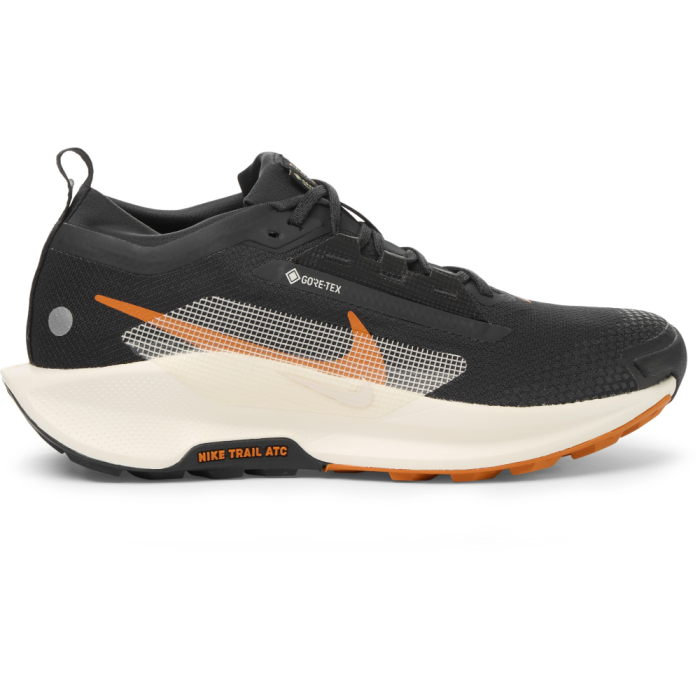
Nike Pegasus Trail 5 GTX
Best waterproof trail runners for wet & cool weather
CleverHiker Rating: 3.6/5.0
Price: $180
Weight (Pair): 1 lb. 4.3 oz.
Heel-to-Toe Drop: 9.5 mm
Cushioning: Moderate
Best For: Mixed terrain
Pros
- Good traction on mixed terrain
- Cushy, improved midsole
- Waterproof
- Comfortable
- Gaiter-like ankle cuff keeps out debris
- Heel and tonge tab for easy on / off
- Rocker shape
- Good lacing system
Cons
- Runs narrow and short – go up half a size
- Less durable than some
- Tall heel-to-toe drop isn't for everyone
- Runs hot (common for GTX shoes)
- A bit soft on steep uphills / downhills
If you’re a year-round runner undeterred by wet, muddy, and snowy conditions, the Nike Pegasus Trail 5 GTX are the shoes for you. These are waterproof powerhouses that offer good traction, a comfortable ride, and a reasonable weight to keep you moving on slippery asphalt and puddle-filled trails.
The Pegasus Trail 5s are incredibly comfortable thanks to updated, cushy midsoles that feel springy and supportive on long runs and hikes. The responsive foam through the heel is forgiving but springy. We’re big fans of the gaiter-like cuff, which hugged our ankles closely to block out debris, gravel, and dirt from entering our shoes.
This Nike model gets an update with a more rockered profile. We find the combination of a higher stack height and tall heel-to-toe drop performs especially well on hard packed trails, concrete, and gentle slopes. We also like the redesigned tread pattern, with plenty of rectangular lugs across the forefoot and heel for increased traction even in mud and light snow.
In general, we’re not big fans of Gore-Tex trail runners for warm weather and summer months because they run hot and don’t offer much ventilation. The Pegasus Traiil 5s are no exception, so we recommend stashing these for cooler weather in fall, winter, and spring when the added warmth is welcome.
Our biggest complaint comes down to the fit, though. It’s more narrow than the prior version, and it’s not offered in wide – which may not suit everyone’s needs. The tall heel to toe drop and stack height also take a bit of getting used to, although heel-strikers and those who prefer a cushioned ride will dig this design. This unusual combination drops it to the bottom of our list.
Finally, the Gore-Tex requires a bit of quick maintenance to keep the shoes waterproof. We always keep a quality, shoe-specific waterproofing spray to help seal your shoes and keep the water out.
Still, these are the only Gore-Tex shoes to make our list for a reason. For folks with a year-round training schedule, the Pegasus Trail 5s are an excellent choice. They’re spendy, but we think they’re worth every penny for those who need durable and waterproof shoes for the road or trail – no matter what the elements are doing.
More: Nike Pegasus Trail 5 GTX Review
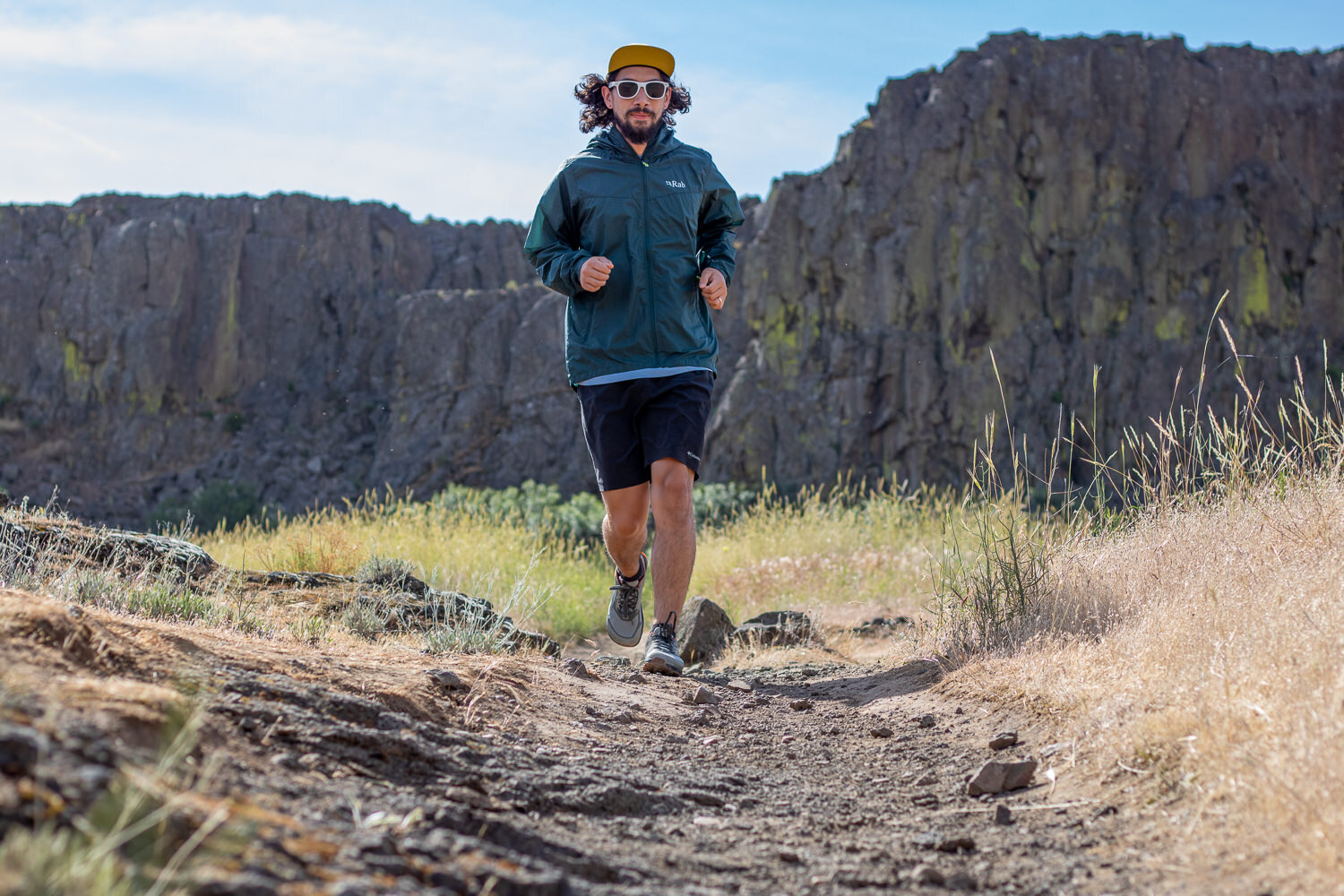
Product Comparison Table
| oSort | Product | Price | Weight (Pair) | Heel-to-Toe Drop | Cushioning | Best For | Comfort | Traction | Weight Score | Durability | Breathability | Responsiveness | 0 |
Brooks Catamount 4 View at REI View at Amazon |
$170 | 1 lb. 3 oz. | 6 mm | Moderate | Mixed Terrain | 4.6 | 4.6 | 4.8 | 4.8 | 4.8 | 4.3 | 1 |
Nnormal Kjerag 01 View at REI View at Nnormal |
$195 | 14.5 oz | 6 mm | Minimal | Technical / Trail | 4.3 | 4.5 | 5 | 4.5 | 4.4 | 4.9 | 2 |
La Sportiva Bushido III View at REI View at Amazon |
$155 | 1 lb. 5 oz. | 6 mm | Moderate | Technical | 4.2 | 4.7 | 3.5 | 4.8 | 3.8 | 4.9 | 3 |
Saucony Peregrine 15 View at REI View at Amazon |
$145 | 1 lb. 3.4 oz. | 4 mm | Moderate | Mixed Terrain | 4.4 | 4.4 | 4.7 | 4.4 | 4.6 | 4.7 | 4 |
Salomon Speedcross 6 View at REI View at Amazon |
$145 | 1 lb. 5 oz. | 10 mm | Moderate | Mixed terrain | 4.6 | 4.8 | 3.8 | 3.9 | 4.3 | 4.4 | 5 |
HOKA Torrent 4 View at REI View at Amazon |
$130 | 1 lb. 1.4 oz. | 5 mm | Moderate | Trail | 4.5 | 4.2 | 4.6 | 3.3 | 4.7 | 4.6 | 6 |
Topo Athletic Ultraventure 4 View at REI View at Amazon |
$150 | 1 lb. 4.8 oz. | 5 mm | Moderate | Trail | 4.7 | 4.3 | 4 | 4.1 | 4.4 | 4.3 | 7 |
The North Face Vectiv Enduris 4 View at REI View at Amazon |
$160 | 1 lb. 4.2 oz. | 6 mm | Maximum | Mixed Terrain | 4.9 | 4.3 | 4.4 | 4.7 | 3.6 | 4.4 | 8 |
HOKA Speedgoat 6 View at REI View at HOKA |
$155 | 1 lb. 3.6 oz. | 5 mm | Moderate | Trail | 4.7 | 4.5 | 4.5 | 3.6 | 4.5 | 3.8 | 9 |
Brooks Cascadia 18 View at REI View at Amazon |
$140 | 1 lb. 7.3 oz. | 8 mm | Moderate | Mixed terrain | 4.1 | 4.1 | 3 | 3.8 | 4 | 4.3 | 10 |
Altra Lone Peak 9 View at REI View at Backcountry |
$140 | 1 lb. 6.4 oz. | 0 mm | Moderate | Trail | 4 | 4.4 | 3.2 | 3 | 4.2 | 4.8 | 11 |
Nike Pegasus Trail 5 GTX View at REI View at Amazon |
$180 | 1 lb. 4.3 oz. | 9.5 mm | Moderate | Mixed terrain | 4.2 | 3.8 | 4.2 | 3.3 | 3 | 3.9 |
|---|
How We Test & Methodology
Our testing protocol involved a minimum of 10 trail runs per shoe – although in most cases, many more – across a variety of real-world conditions. We scrutinized each pair based on Comfort, Traction, Weight, Durability, Breathability, and Responsiveness everywhere from gravel roads to scorching hot pavement, and wet mountain trails to gnarly technical slopes. We tested all shoes in rain, snow, and hot weather in the dusty central Utah desert as well as the mucky high alpine of the Colorado Rockies in spring.
COMFORT
Comfort is more than just how soft a shoe feels – it’s about how your foot fits inside. We looked out for any areas that felt too snug or too roomy, and we tested several models to see how they handled different foot shapes, running styles, and terrain. After miles of running on a mix of trails and in all kinds of weather, we noted any rubbing, blistering, or uncomfortable movement.
TRACTION
Traction comes down to two things: the rubber on the outsole and the lug pattern. We analyzed how well the soles gripped slick rocks and slippery wood bridges, and how effectively the lugs bit into dirt and mud on steep climbs as well as loose gravel on sharp descents. We also checked if those same lugs got in the way on smooth paths, highlighting which shoes handled every type of terrain from parking lot pavement to alpine scrambles.
WEATHER RESISTANCE
When it comes to weather, we wanted to see how shoes hold up in rain, light snow, and full submersion in creeks and puddles. Did they keep water out or soak through fast? Do they drain well? How quickly did they dry when the sun came back – and what was the speed of drying in a room-temperature, controlled environment? It’s also crucial to understand how well shoes breathe, so we scored shoes by looking at how they keep our feet cool and sweat-free during hot days, or if things got swampy inside.
WEIGHT
We put each shoe on the scale, but numbers only tell part of the story. Out on the trail, we noted which pairs kept our legs fresh all day and which gradually turned into ankle weights as the miles stacked up.
DURABILITY
While midsoles wear down with mileage, durability is also about the upper’s ability to withstand stress, and the outsole’s ability to resist abrasion and separation. We analyzed reinforcement overlays, welding quality, and overall upper construction to detect vulnerable spots. We watch for damage on essential components like the cuffs, tongue, and laces. We also inspected exposed foam areas on the soles to assess their resistance to punctures, tears, and excessive damage in rugged trail conditions. We meticulously noted the mileage to address how long it takes until lugs begin to flatten.
BREATHABILITY
Nobody wants hot, soggy feet. We put these shoes through warm runs and splashed through puddles to see how fast they keep your feet cool and dry. It’s a tough balance – durable but breathable – and we put each pair to the test.
RESPONSIVENESS
We measured responsiveness by how well each shoe propelled us forward and handled sharp turns on rough terrain. Feeling the trail beneath our feet mattered – too much harsh feedback meant tired feet by day’s end. Features like a rock plate, material choice, and longevity all factor into the responsiveness score of each shoe.
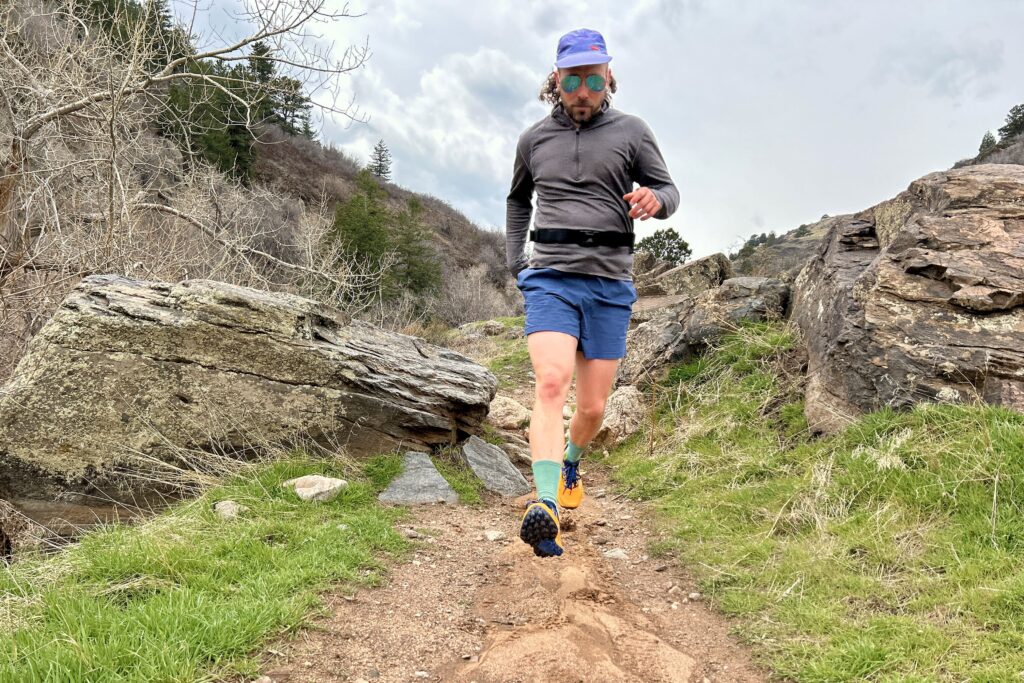
WHY TRUST CLEVERHIKER?
Senior Content Editor Ian Krammer has been hiking and climbing Colorado’s tallest peaks for nearly a decade. With hundreds of thousands of feet of vert, over 5,000 miles of trail, and 600+ peaks over 13,000′ under his belt, Ian’s learned what makes a great shoe when running, hiking, and backpacking on some of the toughest alpine terrain out there. His extensive experience exploring remote backcountry routes in all sorts of weather conditions makes him uniquely qualified to put men’s running shoes through their paces and determine what makes each pair worthy of a spot on our gear guide.
Analysis & Results
Most comfortable trail runners
Best trail runners with a wide fit
What’s Most Important to You in a Trail Running Shoe?
COMFORT & FIT
Shoe comfort and fit are extremely individual, since everyone has slightly different foot shapes and sizes. However, we generally recommend looking for running shoes with a flexible but supportive sole, enough room for your toes to wiggle, plenty of breathability, and cushioning for those long miles.
Most comfortable trail runners
Best trail runners with a wide fit
PRICE
Your feet are the key to your success on trail. The healthier and happier your feet are, the further and faster you’ll be able to go. That’s why, out of all the gear you consider for running, we recommend choosing the highest quality footwear your budget will allow based first on comfort and fit, and then durability.
Best budget trail runners
Best value trail runners
Best high-end trail runners
WEIGHT
Lighter shoes mean less weight for your legs to lift on every step, which translates to reduced muscle fatigue, less tripping and stumbling, and healthier ankles, knees, and hips. That said, if you tend to run on muddy, technical, or complex trails, heavier shoes might be preferable since they’ll hold up better and last longer than lighter options.
Best ultralight trail runners
Best lightweight trail runners
DURABILITY & MATERIALS
Trail runners are intentionally made with lightweight materials so you’ll feel nimble and comfortable while moving fast. The downside of featherlight shoes is they aren’t as durable compared with burlier options. The most durable trail runners are usually reinforced with TPU overlays, have a bit more structure through their uppers, and feature firm, aggressive tread patterns on the sole.
Most durable trail runners
HEEL-TO-TOE DROP
Heel-to-toe drop measures, in millimeters, the difference in height between the heel of the shoe versus the toe. While millimeters may seem like a measurement too small to notice, heel-to-toe drop dramatically affects your gait when you’re walking or running. It also plays a major factor in how efficient your stride is and how comfortable your ankles, knees, and hips feel during a run.
The shoes on this list range from 10 millimeters to the lowest possible, 0 millimeters. With zero-drop shoes, your foot is the same distance off the ground from back to front, which can put less stress on your joints and facilitate a more natural step. However, everybody is different, and finding the right height for you depends on your unique foot shape, running style, personal preference, and trail conditions.
Best zero-drop trail runners
Most supportive trail runners
Critical Footwear Considerations
SIZING
For the best fit, consider getting trail running shoes at least half a size bigger than usual, since feet can swell during long runs. But, how can you tell if there’s enough room? Place your foot in the shoe with your toes up against the toe box. You should be able to slide your index finger easily between your heel and the back of the shoe – if there’s enough room, it means your toes won’t jam into the toe box on descents and steep sections of trail.
Sizing is also based on whether the shoe runs narrow or wide, and what kind of arch support you’ll need. When you’re choosing a size, also take into account the specific socks you plan to wear, and if you’re adding aftermarket insoles – a trail runner that’s a bit too big is better than one that’s too small.
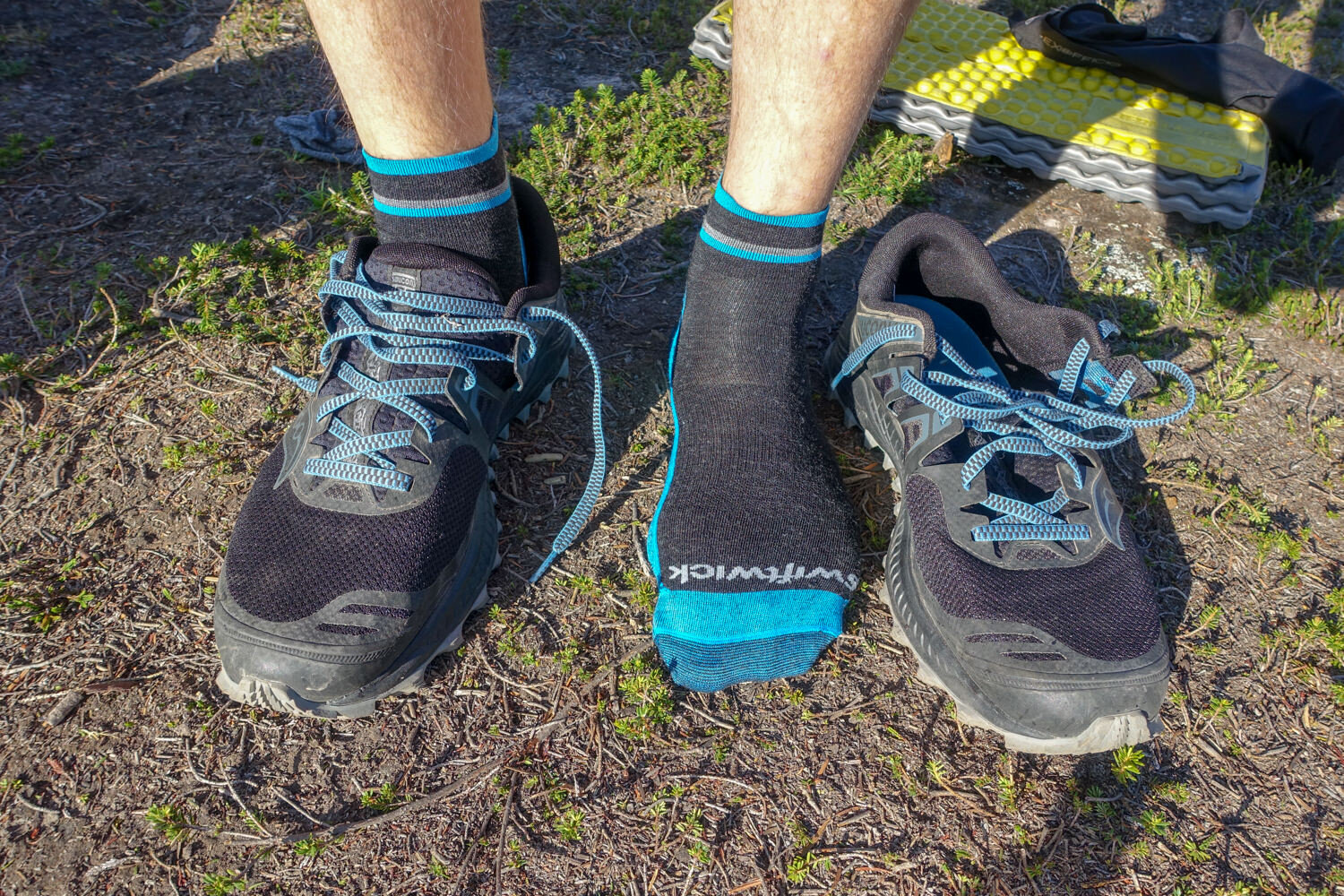

HIKING
At CleverHiker, our absolute favorite footwear for hiking is trail runners. For the same reasons trail shoes are perfect for running – lightweight, flexible, breathable, and supportive – we love them for hiking and long backpacking trips. In fact, our team has collectively hiked tens of thousands of miles in trail runners in extreme places all over the world – from the Rockies to the Andes, and the Smokies to the Himalayas – and we’ve run half and full marathons in them. They’re our go-to shoes from spring until fall and continue to be the most popular footwear for thru-hikers on the CDT, AT, and PCT. Pop over to our Best Hiking Shoes for Men guide to see which trail runners are our favorites for hiking.
MANAGING MOISTURE & BLISTERS
Your feet are bound to get wet when you’re running, no matter what shoes you choose – if you run long and consistently enough, soggy conditions or a big storm are all but inevitable. But, wet feet are the precursor to hot spots and blisters, so it’s crucial to know how to manage moisture and prevent issues ahead of time. Luckily, regular foot care can prevent and handle most injuries and irritations. For more about how to manage moisture and hot spots, see our guide on How to Prevent and Treat Blisters.


WATERPROOFING TREATMENTS
When it’s been rainy for days but you’ve still got to get on the trail, waterproof shoes are a great choice. They’re especially helpful during spring and fall days full of mixed rain, snow, and sun. However, keep in mind that “waterproof” doesn’t actually mean waterproof – ongoing rain showers, slippery creeks, and deep puddles will eventually soak your feet. To keep your shoes sealed, you’ll need to regularly reapply a treatment so you can keep your feet happy and dry.
SOCKS
Quality socks can make all the difference between a fun, satisfying, and healthy run on trail and giving up halfway to hobble home due to pain or blisters. Look for socks that are comfortable, durable, and made with materials like merino wool, polyester, and nylon. These fabrics effectively wick moisture away from your skin, dry quickly, and still retain their shape to avoid rubbing or hot spots. For reviews of our favorite socks for running and hiking, see our guide to the Best Hiking Socks.
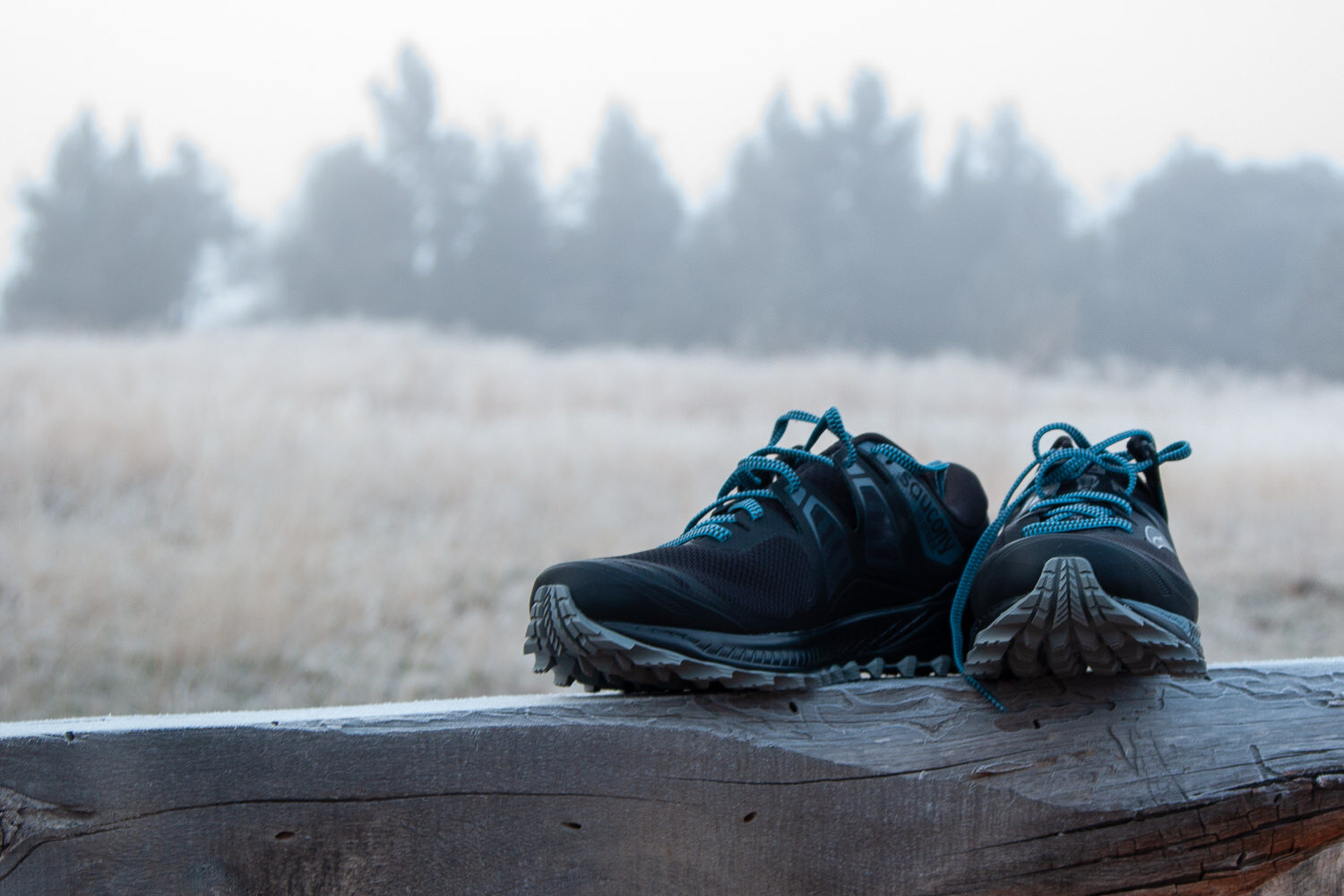
INSOLES
Aftermarket insoles can address a number of foot pains. If you’re dealing with chronic pain from issues such as plantar fasciitis, need support for a specific arch height, or simply want extra support in a rigid shoe, swapping out insoles is an easy solution. If you like a tighter fit or you’re in between sizes, new insoles are helpful for taking up a bit more room in your trail runners.
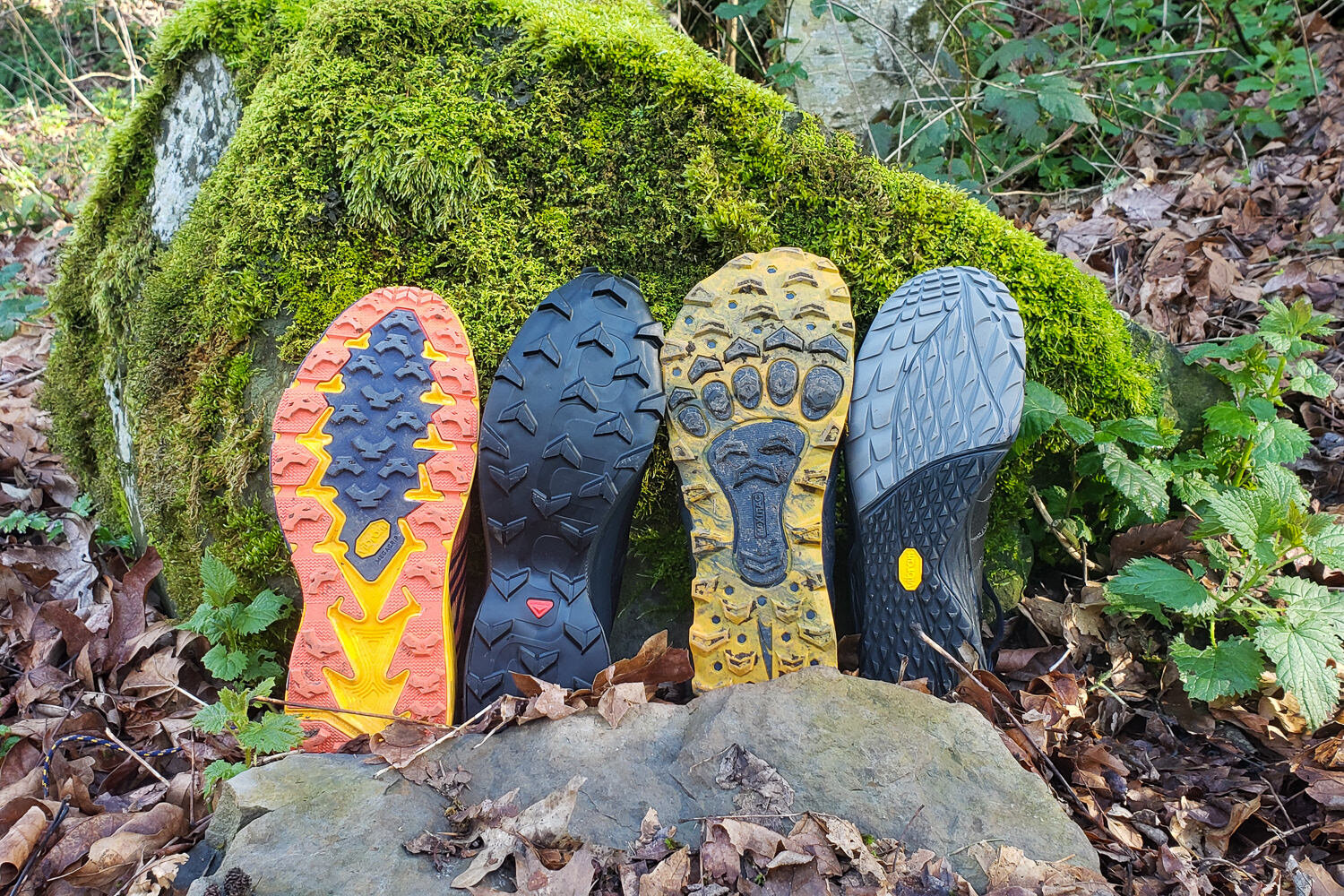
GAITERS
Gaiters are an excellent barrier to stop gravel and sand from getting into your running shoes and causing irritation, pain, and even blisters. We highly recommend a lightweight pair of gaiters to add a bit of extra protection while you’re racing along. Some shoes even have a Velcro gaiter attachment built in.
